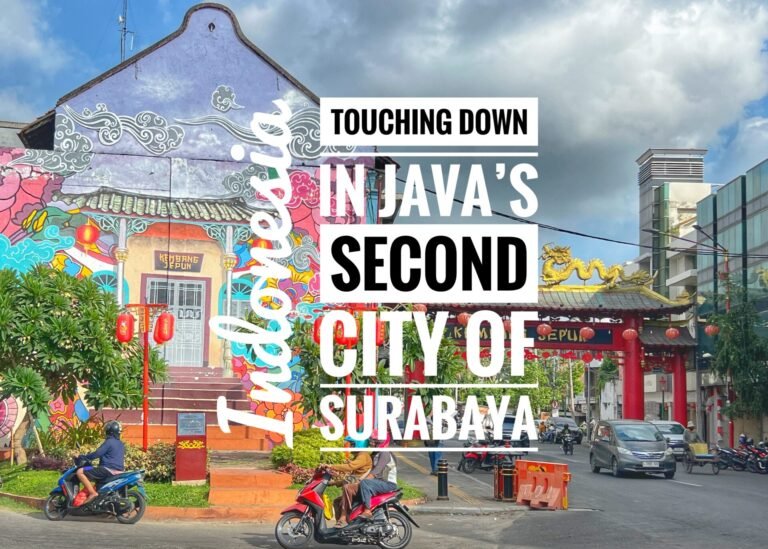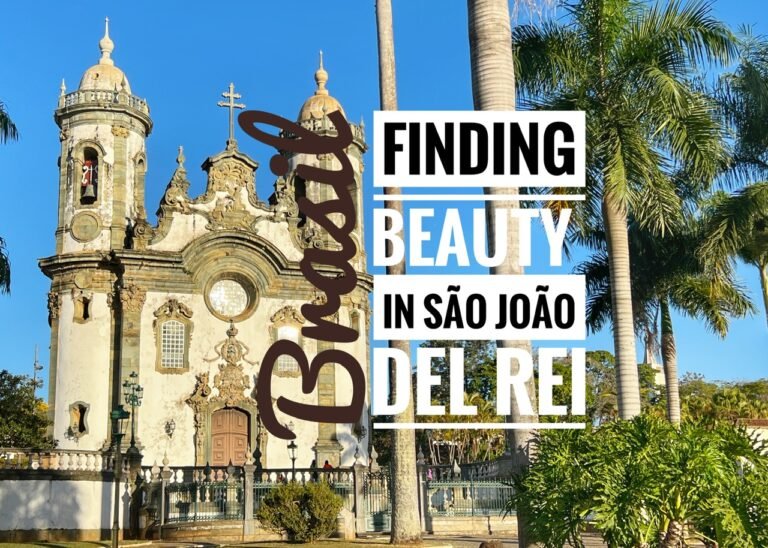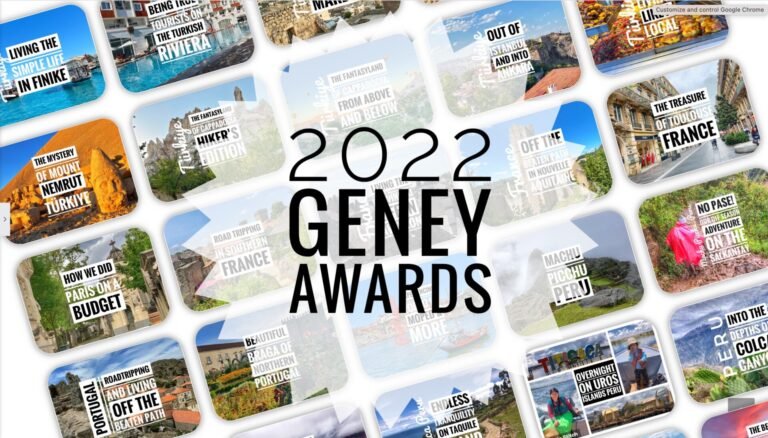
After a day with an internet hit, fluffy pillows, and getting officially stamped out of Colombia and into Brazil, it was time to graduate from Amazon Light to the “real” Amazon. This leg would take us 3-4 hours up a Brazilian/Peruvian Amazon tributary to Palmari Nature Reserve, and encompass our biggest budget splurge since our Tanzanian safari in 2019.

Getting There
In a completely foreign to Greg and Mandy fashion, we were picked up and shuttled around by a tuki tuki and an accompanying man on a motorbike named Polo, who served as the logistics and financial manager on the Letitica end for the reserve. Other than picking us up hours early (again), he was super helpful. They assisted us in handling certain tasks like getting our customs stamps and handling the final payment for the reserve. They then delivered us to our boat captain in the Brazilian port of Tabatinga. We have to admit, it was nice to be taken care of for once!

Our boat captain and his son who would take us deep into the Amazon. Also on our ride were two Aussie guys who we ended up making friends with.
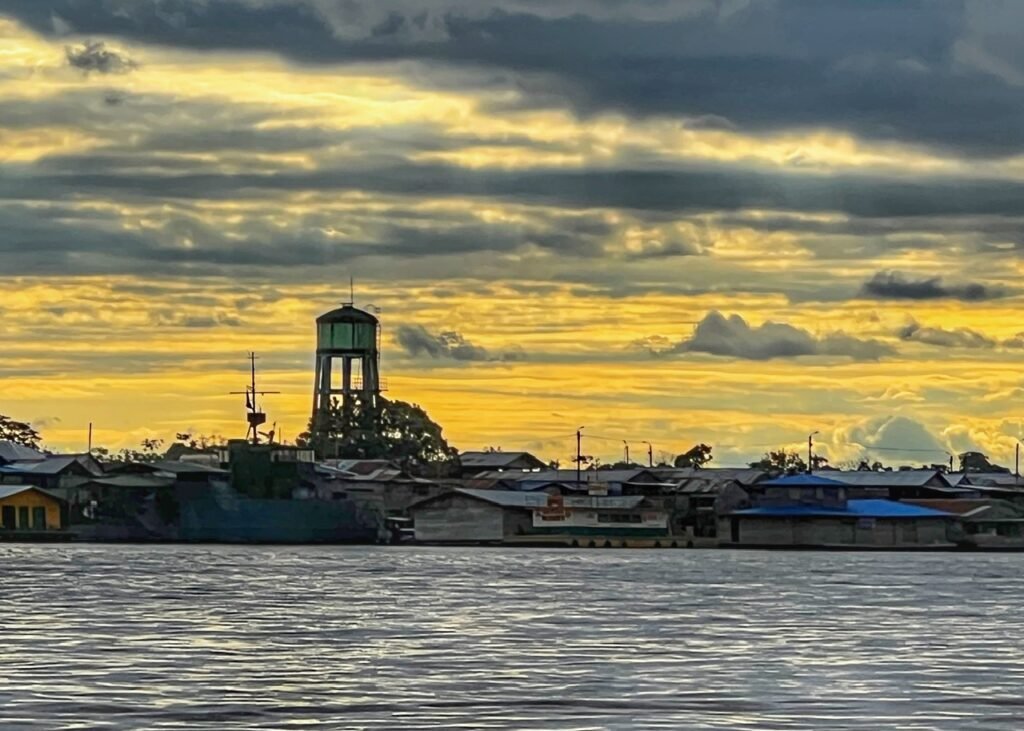
The Brazilian port village of Benjamin Constant. Not sure who it’s named after but pretty sure that guy isn’t from around here.
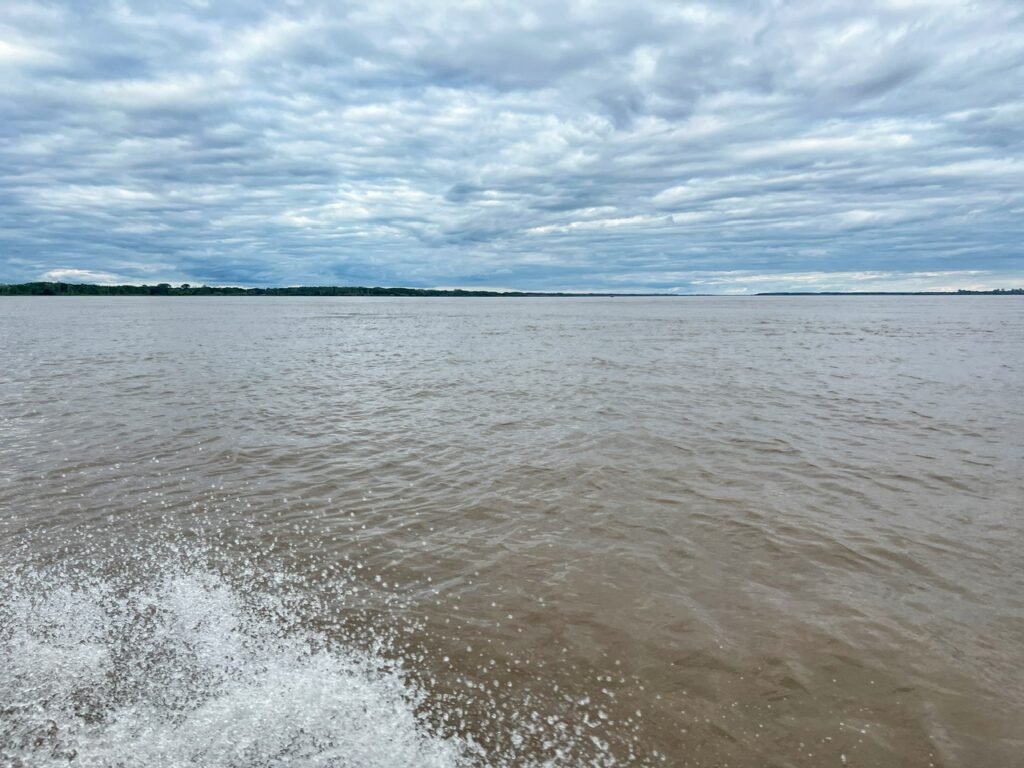
The mighty and undeniably widest river in the world, Rio Amazon is a massive sea of cafe-con-leche-colored water. There are places where it is stretches a full 50 kilometers (31 miles) from bank to bank. And although this fact is debated, it’s also the second longest with the Nile beating it by a hair. The Amazon discharges more water than the next seven biggest rivers combined and its tributaries of Rio Negro and Madeira are themselves among the top ten in the world. (Lonely Planet)
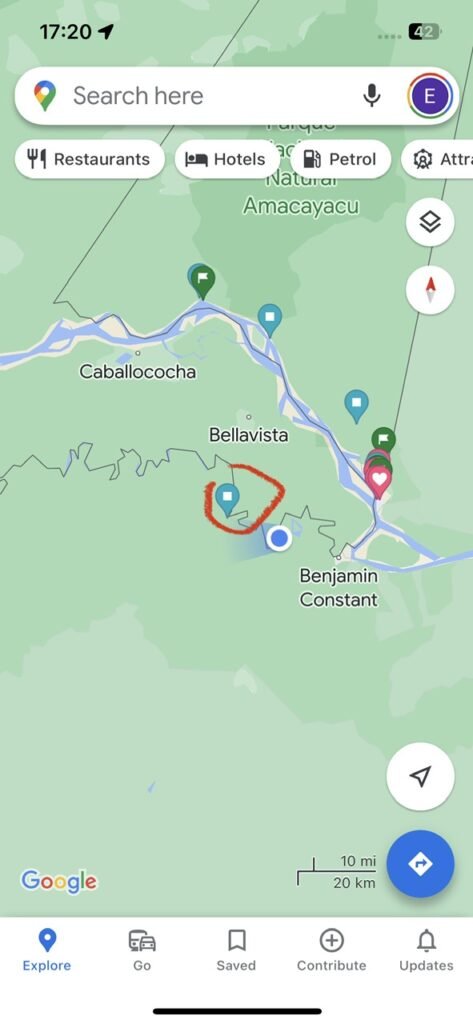
But then, we veered off the Amazon and onto a tributary, which was the size of what we’d consider a “normal” river. Our lodge is circled in red.
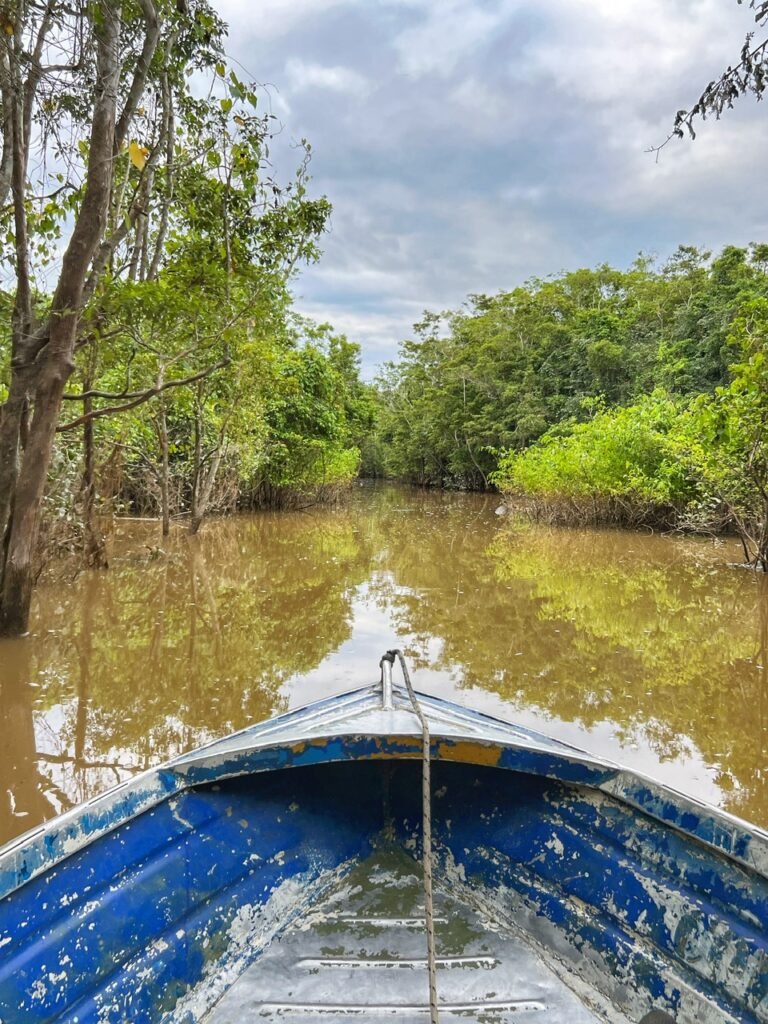
And on many occasions, we then deviated even further into mangrove shortcuts which really increased the wild and wow factor.
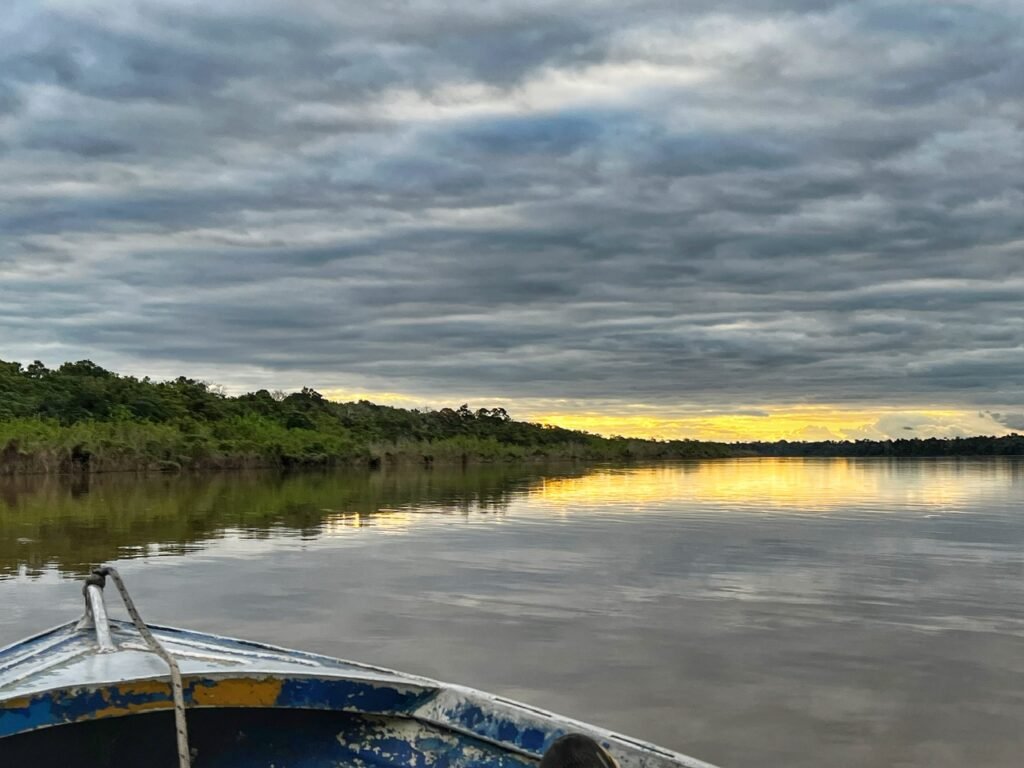

Catching the sunset was a nearly daily occurrence on the river. June is considered a shoulder season between wet and dry and we saw very little rain. It was beyond tranquil.
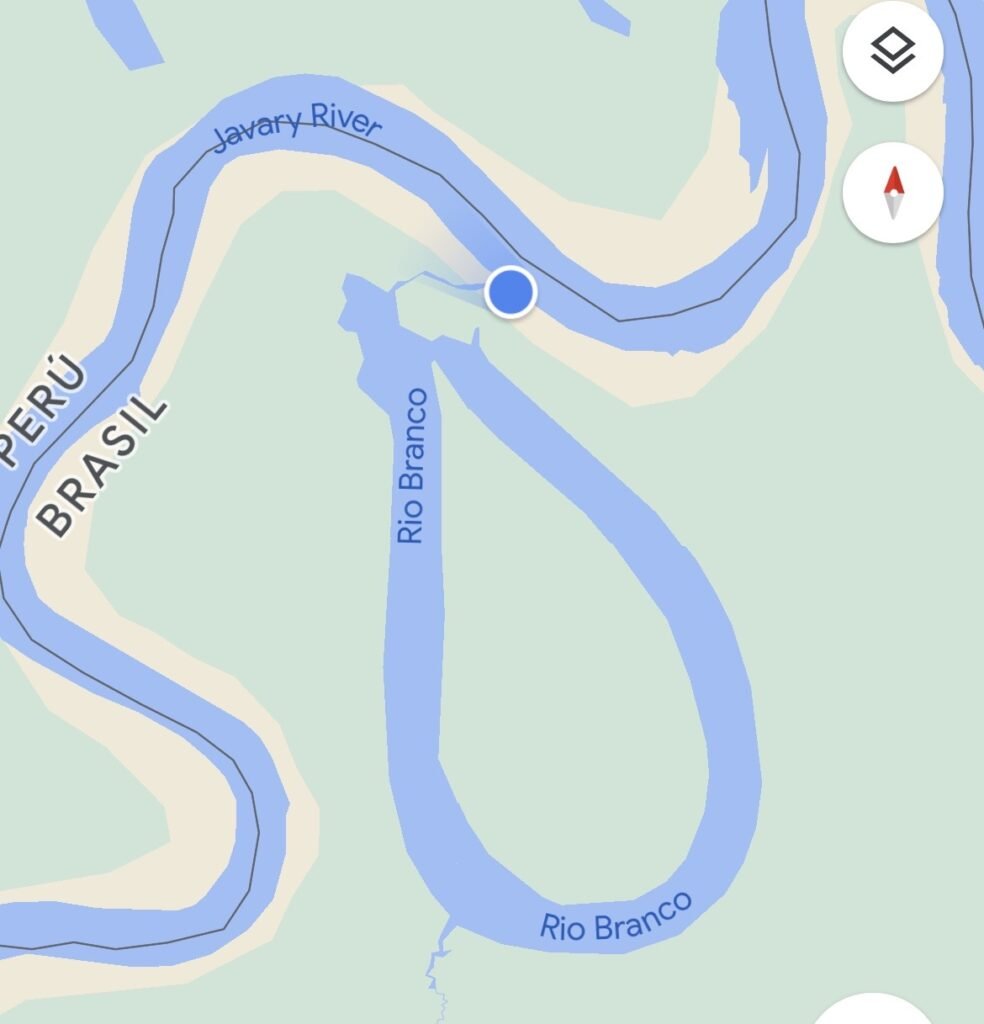
The shortcuts we took, including part of this loopty-loop looked so puzzling on the map. Of course, many of the waterways didn’t even show, like the ones connecting it.

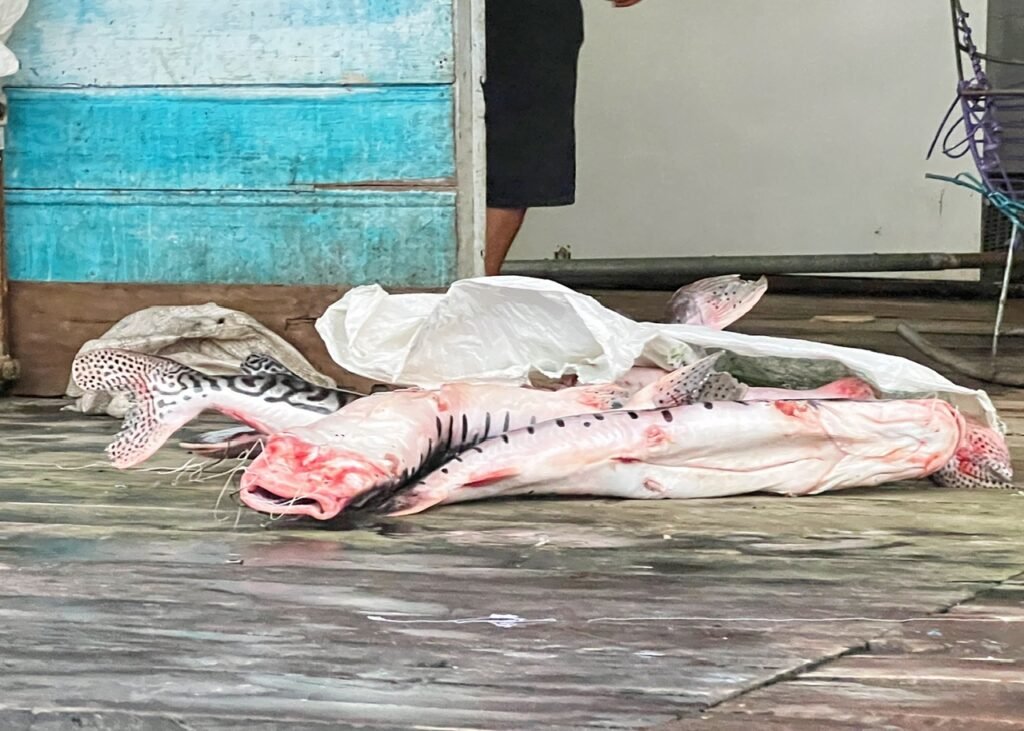
The nearest “big” village to the reserve was called Puerto Amelia. It was incredible to see the cell towers and electricity even this far out. In Puerto Amelia, our boat captain stopped to pick up what would feed us at least a couple of meals at the reserve. This freshwater fish with exquisite tigeresque markings is called Pintodillo and we both agreed, the most marvelous fish of our lives.
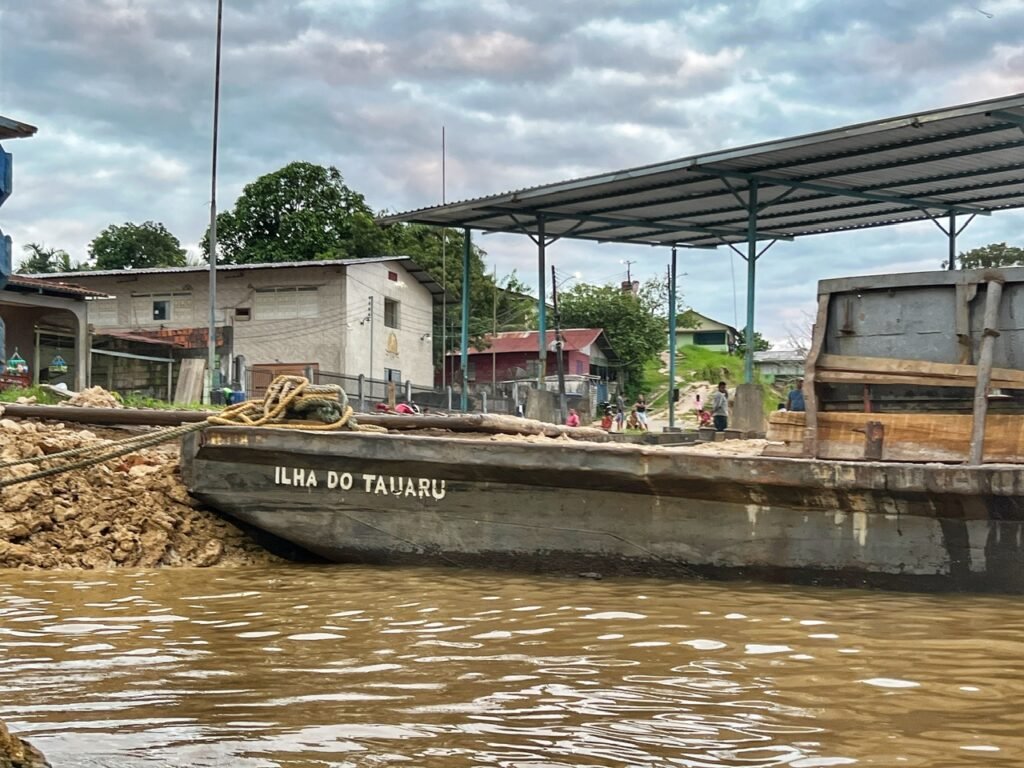
While picking up the fish, we couldn’t help being astonished by the giant bulldozer plowing dirt into this boat.
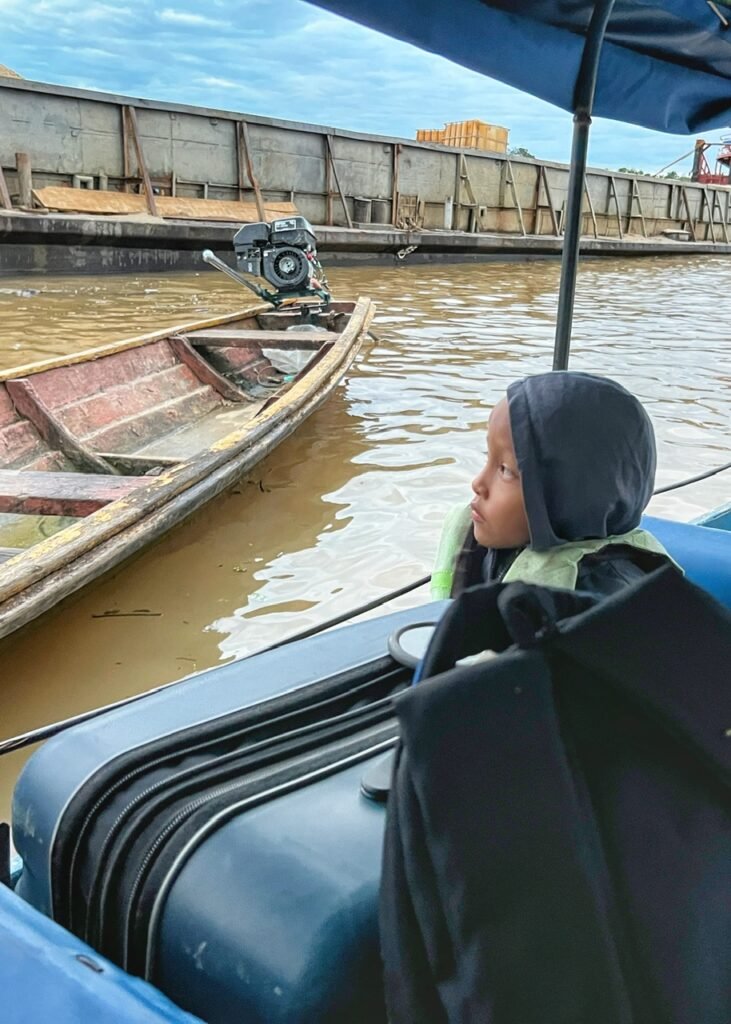
Our little buddy, Samai, did the supervising.
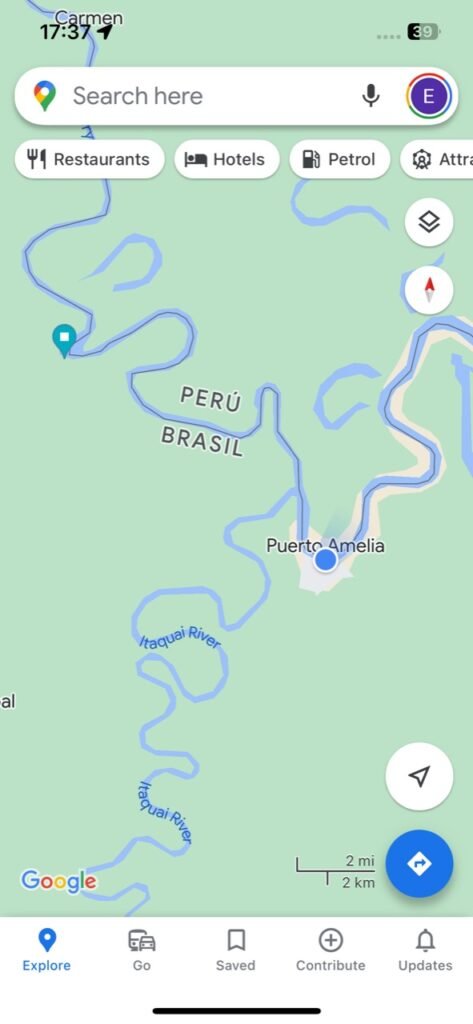
Puerto Amelia, Brazil on the map. After three, were still a good hour from our final destination.
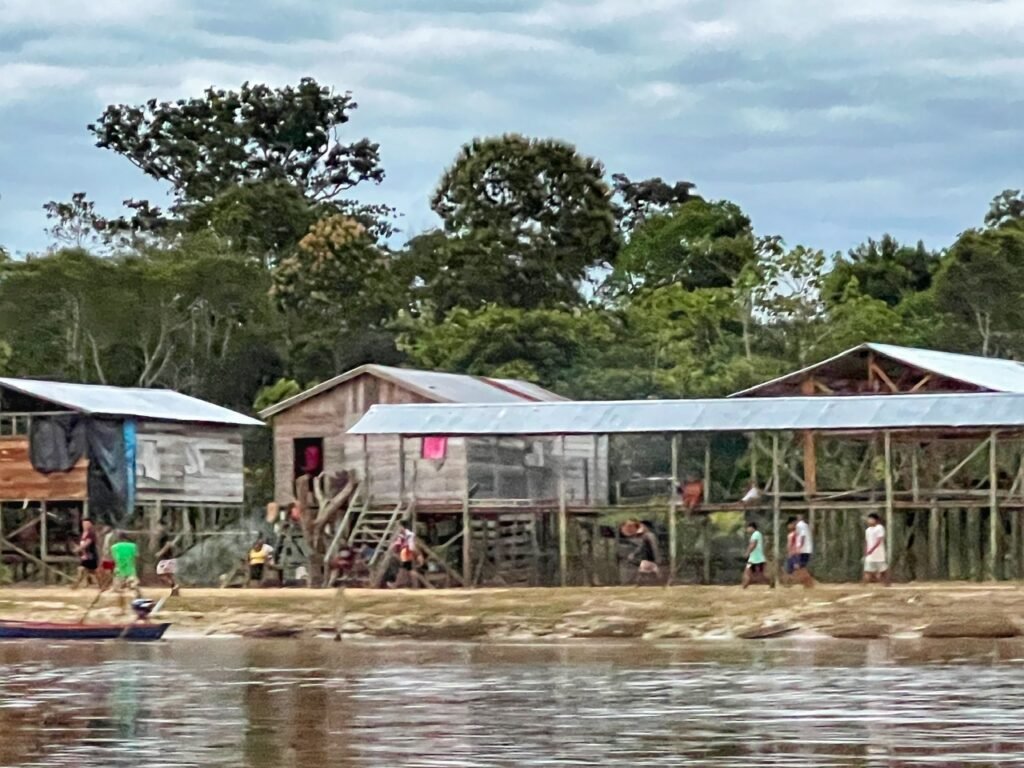
In the meantime, on the other side of the river in Peru, we could see the difference in living standards displaying the obvious difference in wealth of the two countries.

The day fades away so yes, it was well after dark when we finally landed.
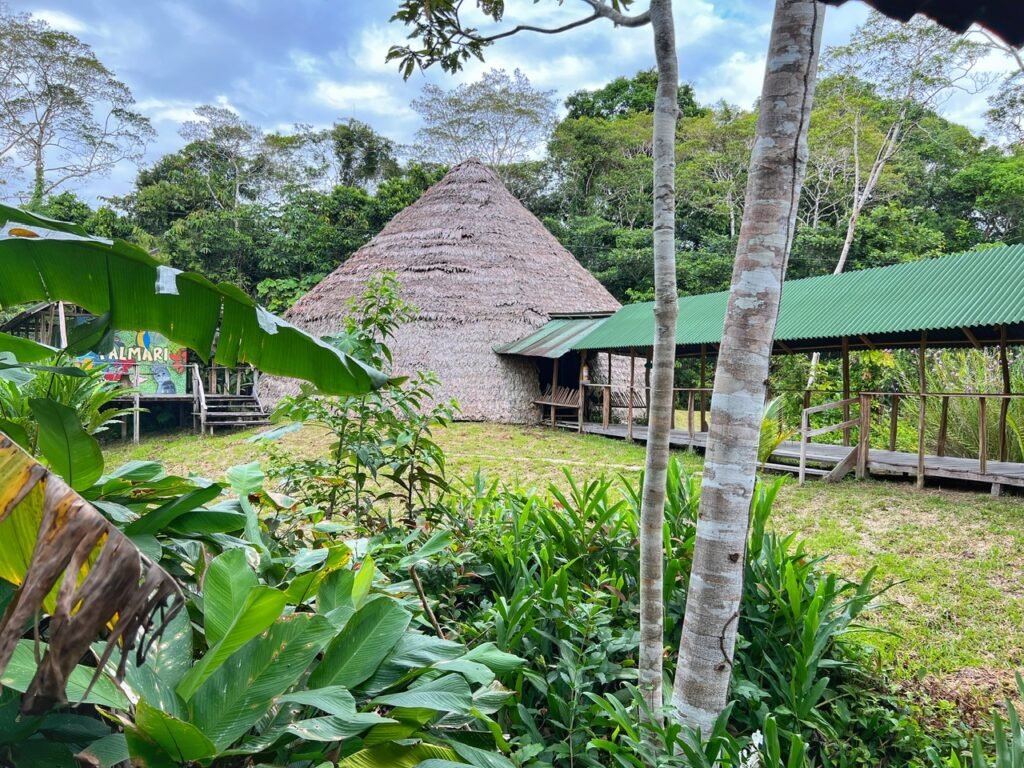
The Reserve & Accommodations
Staying at Palmarí Nature Reserve is like going to the most fun summer camp ever for like-minded adults of all ages. With free beer. Errr….well, not exactly free but along with really top-rate meals and activities, it’s included in your daily rate which for us was $80/person. Yes, a major splurge for us, but undoubtedly worth every peso and a fabulous and authentic way to have a rustic experience in the Amazon for three nights. (Which we could have easily done more!)
Palmarí was developed by a German PhD named Axel in ornithology about 20 years ago. He created the reserve in order to protect and study bird and other species of the Amazon and it has developed into a full-blown lodging and experience operation run by at least 70 local staff members and volunteers from all over, who serve as translators.
Palmarí has different sleeping options for different budgets from a community room hammock to a private cabin with personal bathroom. Not surprisingly, we noticed that most young people gravitated to the hammocks and the 60+ crowd, to the cabins. Considering we were already blowing the budget, of course we chose the cheapest option at $80/each. Fortunately, they upgraded us to beds in the community houses so it ended up working out beautifully and we only ended up in a hammock the night we chose to sleep in the jungle (more on that later!) This photo is of the Maloca house where we slept on the final night.

Lara, the loro, which means parrot, was a constant fixture at the reserve, whether squawking overhead or chilling with the guests.

We slept in the emanada on the first night, along with five other guests. The buzzing, crying and chirping noises of the jungle were indescribable.
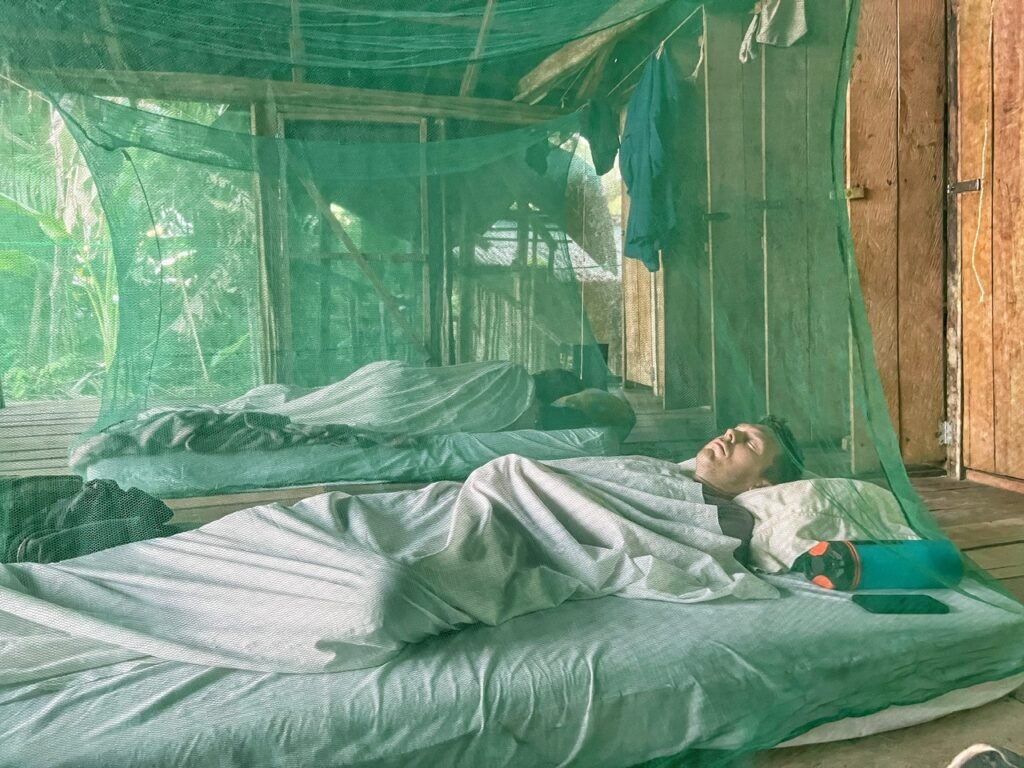
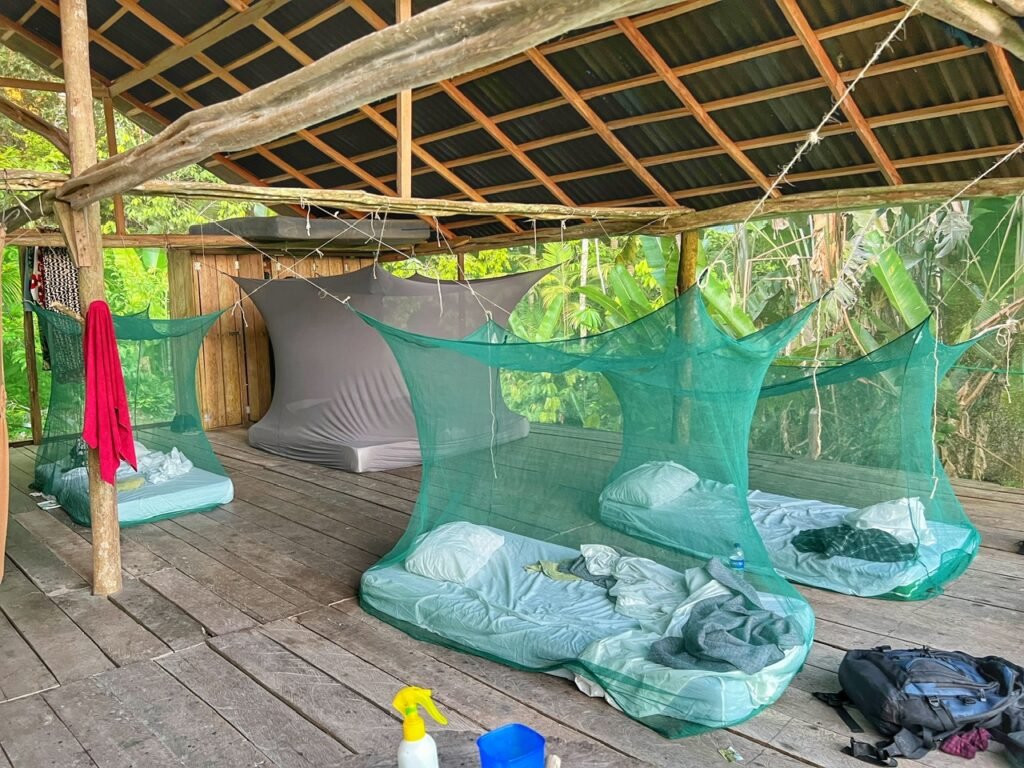
Greg snoozing at 6:00, just before the breakfast bell rang at 6:30. See? Just like camp!! 😁 Each mattress had a quite efficient mosquitero (mosquito net), and included a pillow, towel and sheet. You were also provided a wooden locker in which to keep your things so we were grateful to have locks.
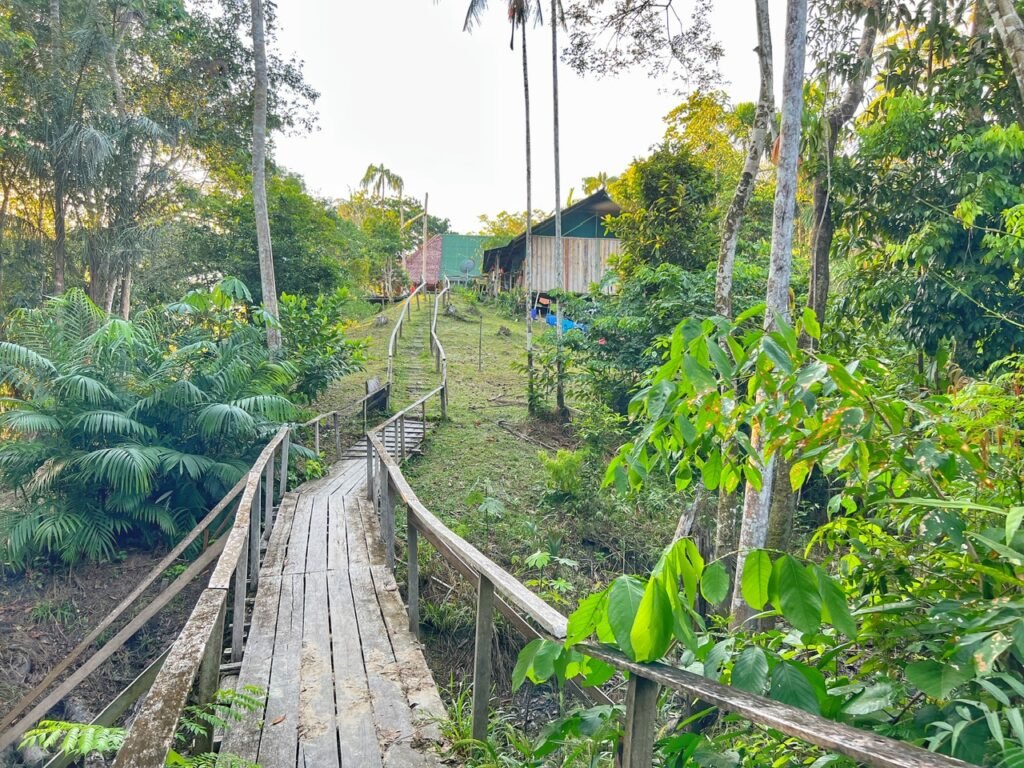
The walk up to the visitor’s center where all meals were provided and wifi was miraculously available. But we were too busy to use it!
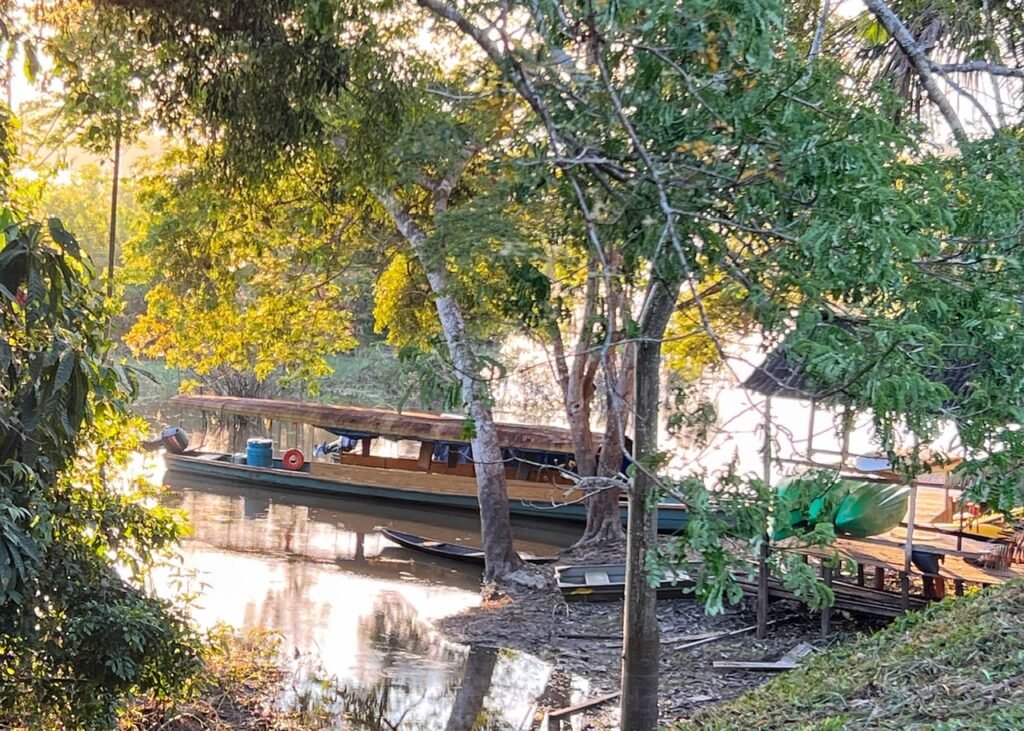
The boat on which we had arrived the night before.
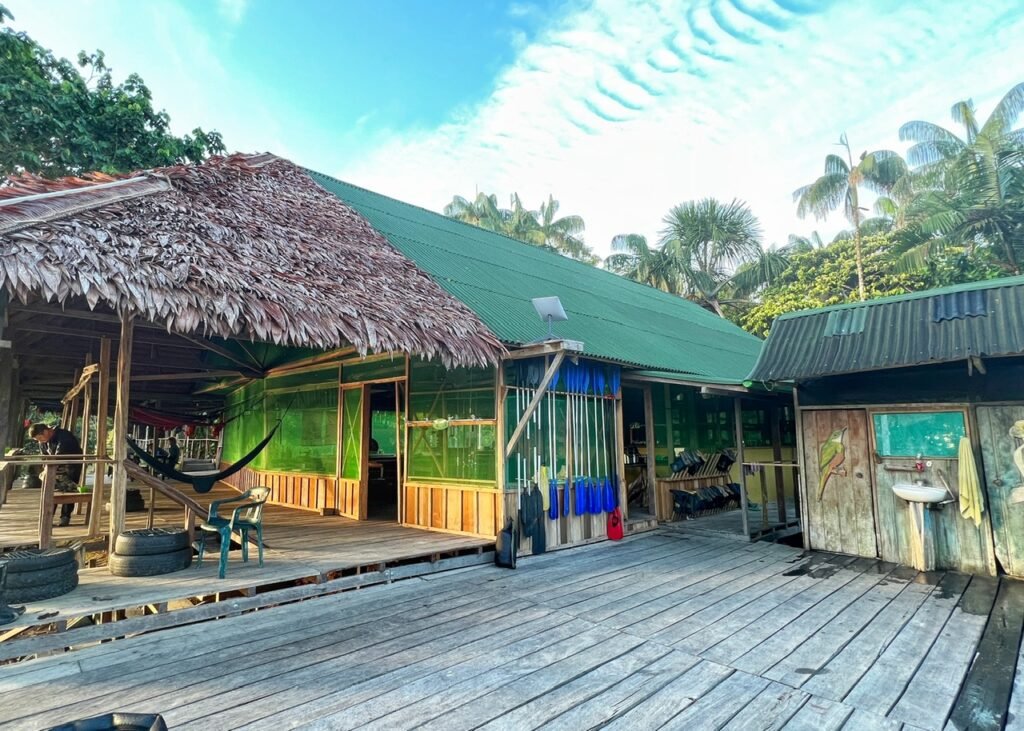
A closer view of the visitor’s center.
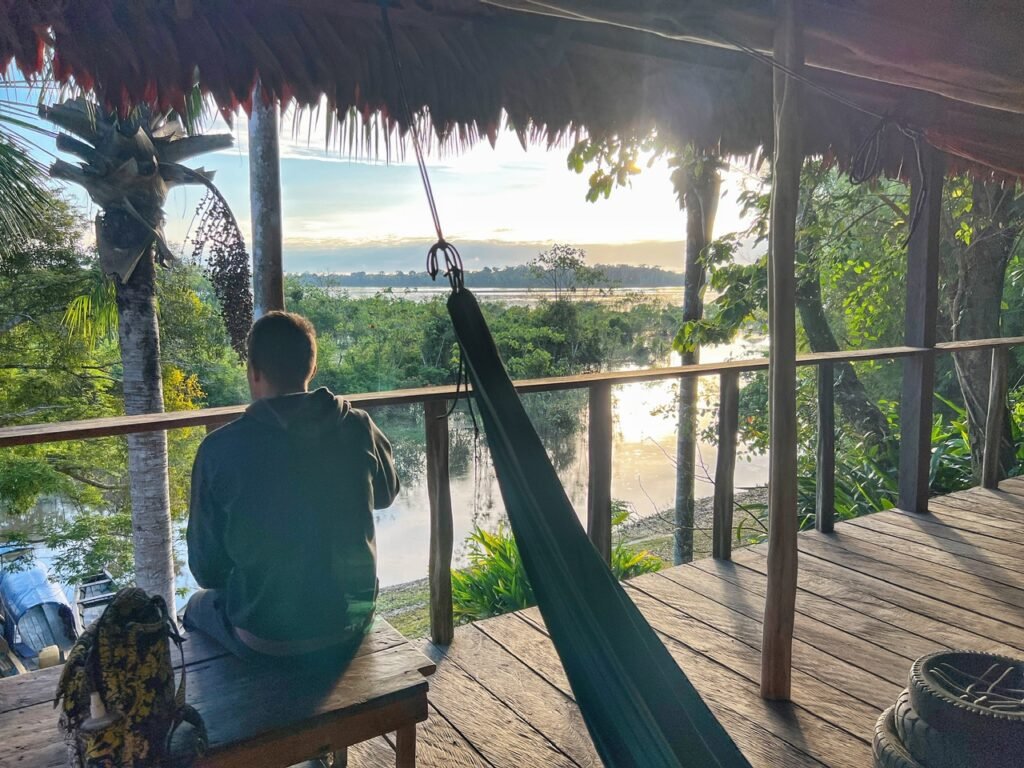
Greg soaking in the view with his morning coffee.
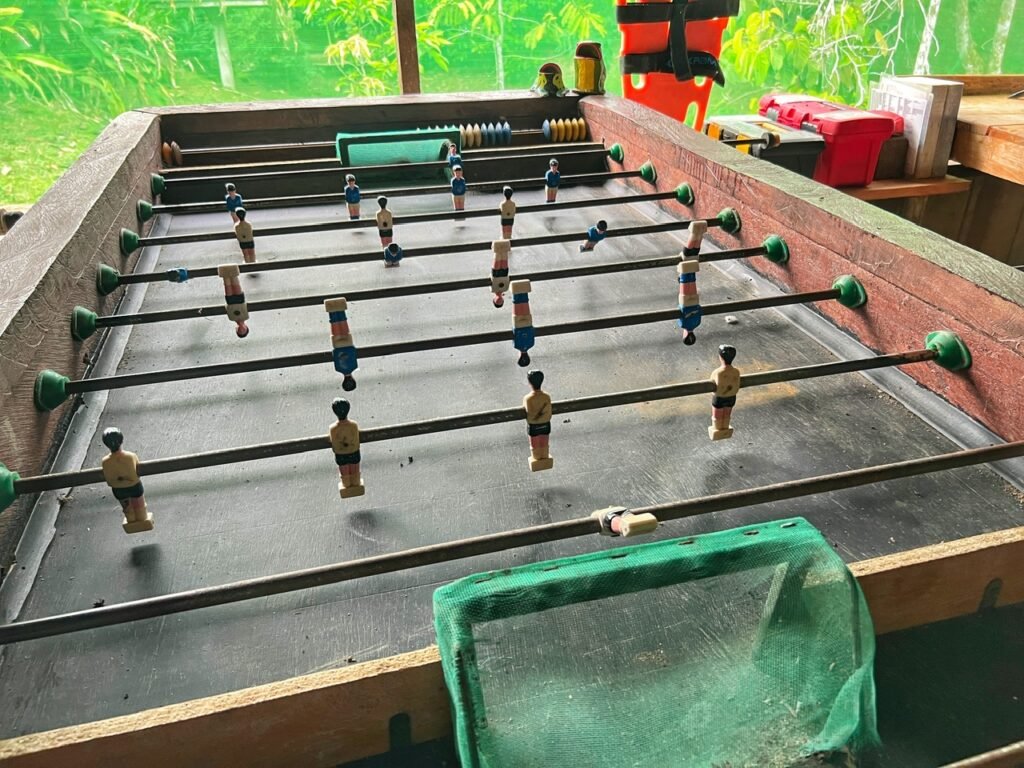
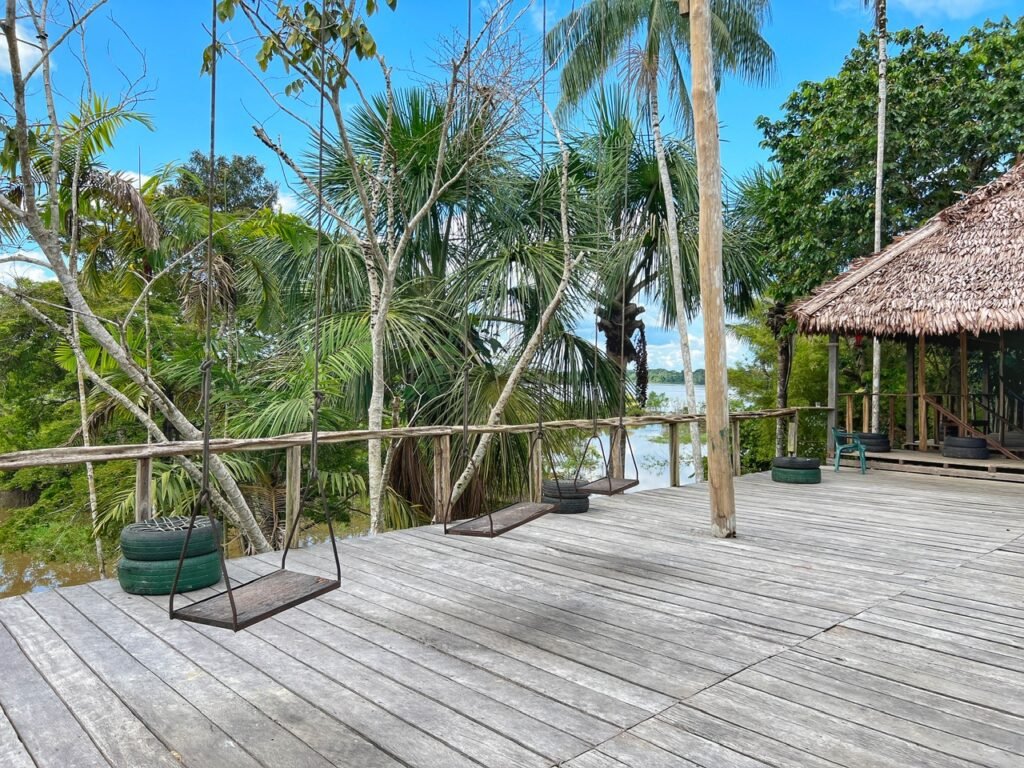
If you didn’t feel like partaking in jungle adventures, there was lots to help you unwind in the visitor’s center in addition to internet, like foosball, magazines and games. Or, columpios! swings!!

Where we had our meals which were served at 6:30, 12:30 & 6:30.

And they were insanely delicious. Some of the best we’ve had in South America (which to be honest, isn’t saying much 🤣) The meals were fantastically seasoned and usually included rice, some type of bean, fish and/or chicken, salads and Amazonian fruit juices. They even asked our food preferences prior to arriving, so Mandy actually got to stick with her pescatarian preference and Greg his gluten free one, which feels unfortunately rare lately.
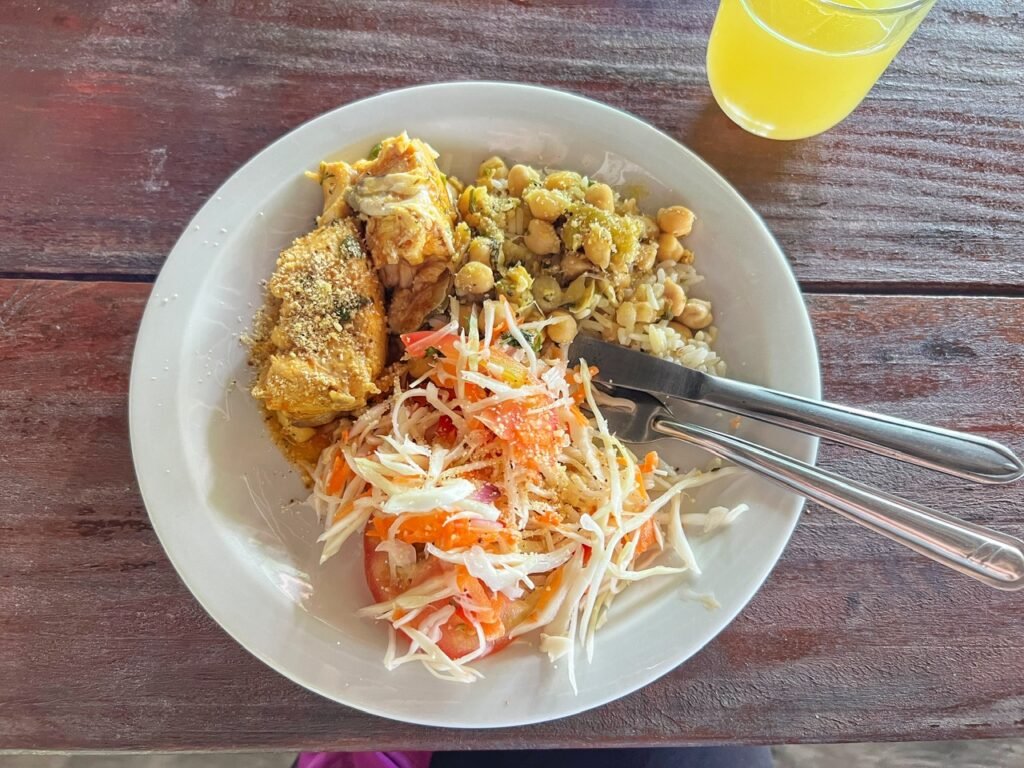
An Amazonian fish, which always seemed to be a bit meatier than the fish we’re used to, salad and seasoned chickpeas with rice.

And it was very easy to make friends here. This table happened to be full of Pacific Northwesterners from the States! (Where we used to live!)
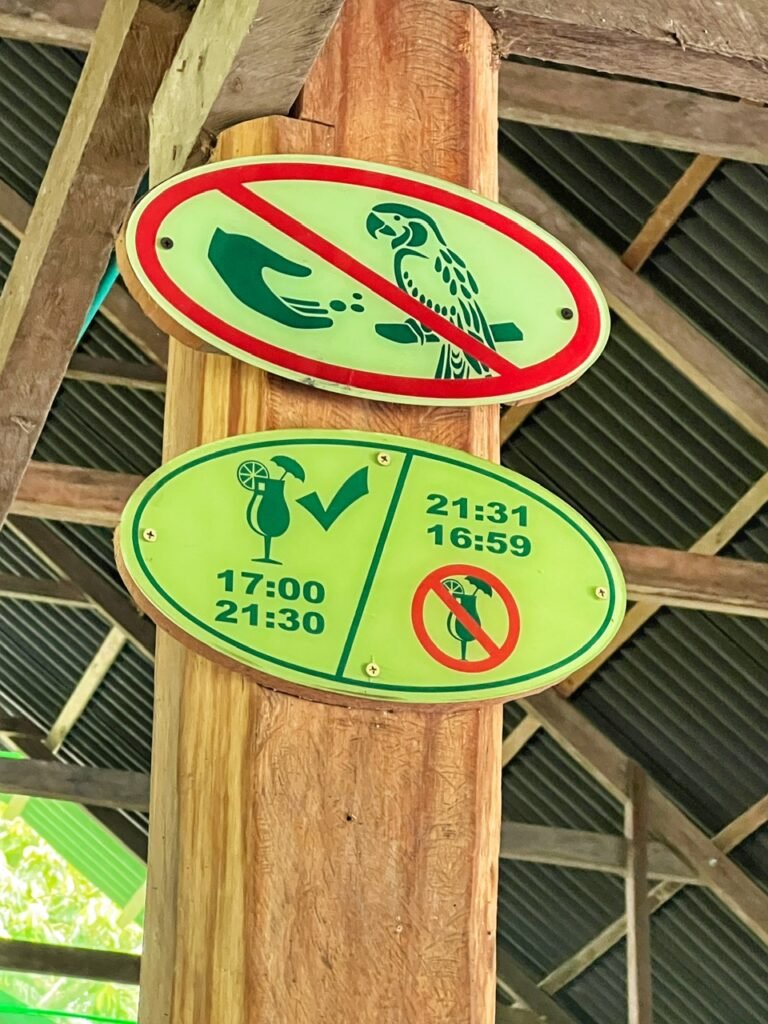
It was extra easy to make friends when alcohol was included. And being the forty something fogies we are, we were completely fine that that they cut off service and encouraged everyone to go to bed at 10. 🤣
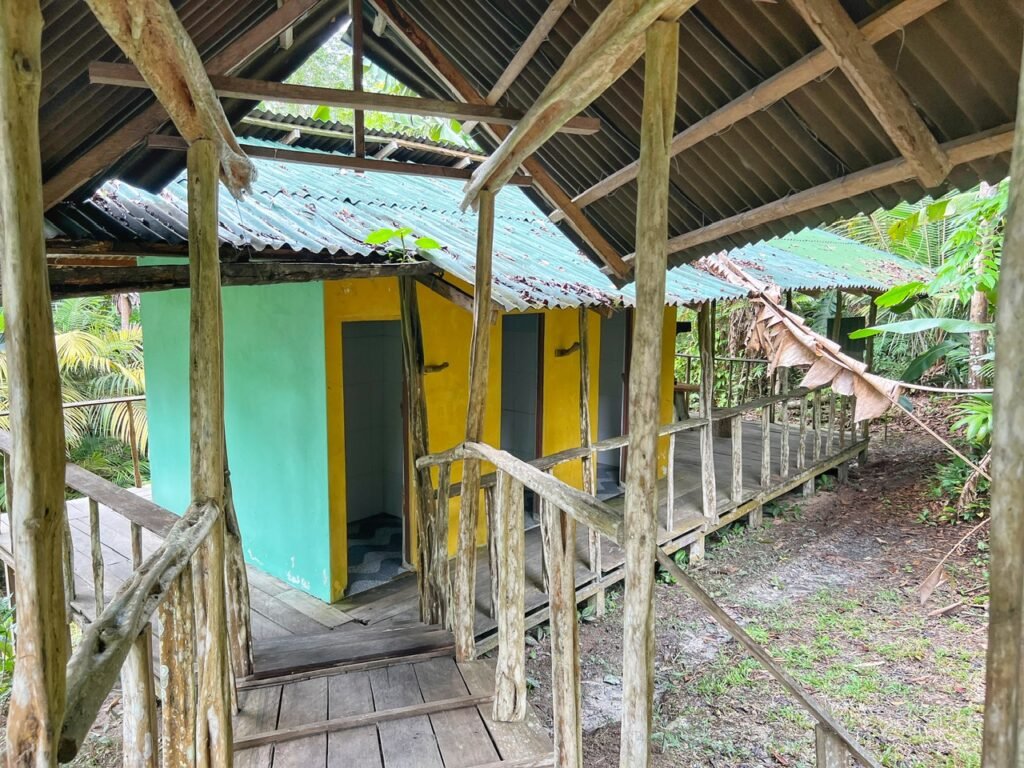
The bath house. It included regular toilets, cold showers (which was definitely fine) and sinks which could also be used for laundry.
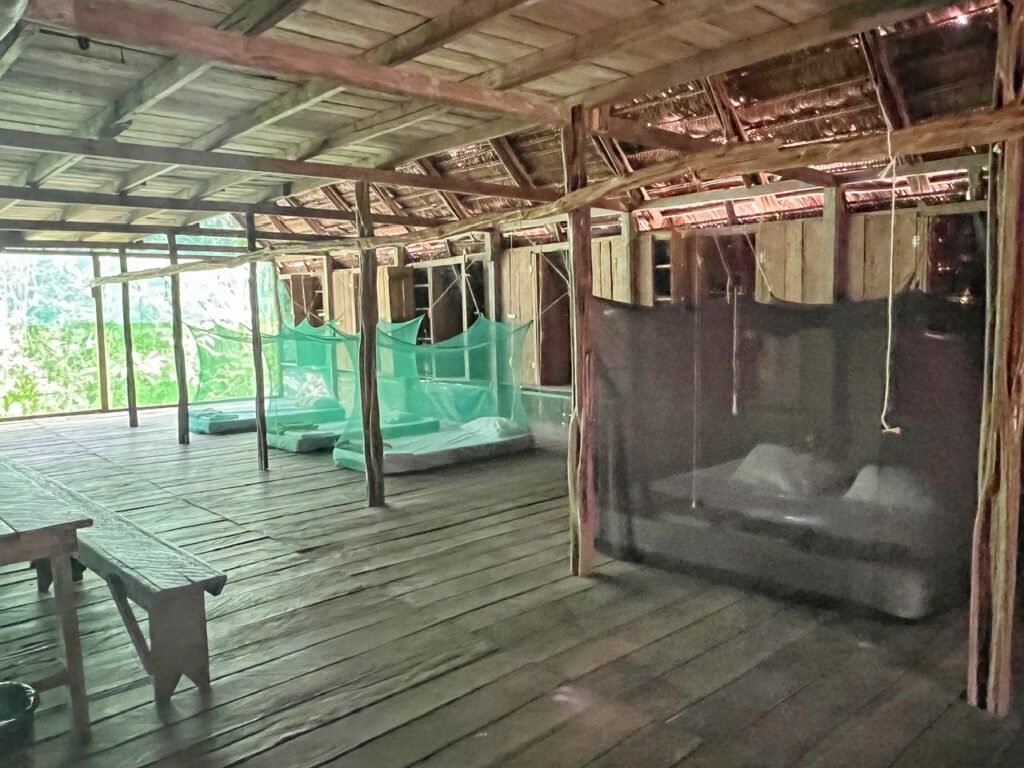
On our final night, we got an even bigger upgrade when they moved us to the Maloca (first photo.) We received a giant queen sized mattress and two pillows, which after our night prior was the lap of luxury 😁.
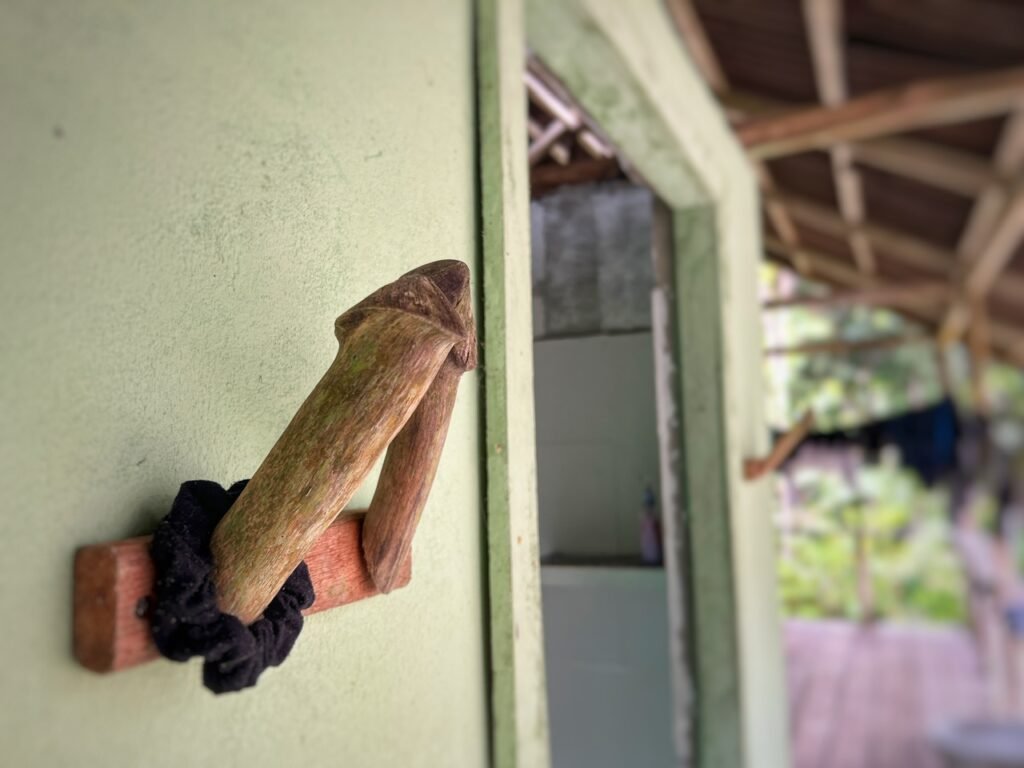
And lots of places to hang things. 🤣
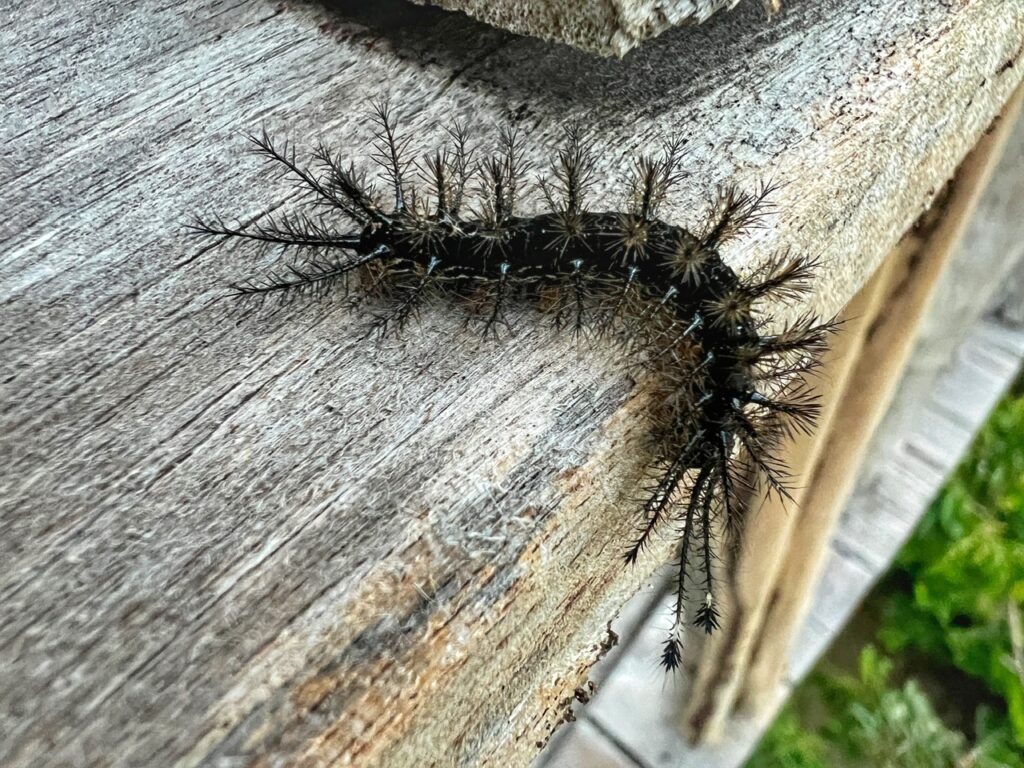
Mandy re-encountered a brother of the bastard caterpillar that stung her in Panama. Except this guy looked even nastier.
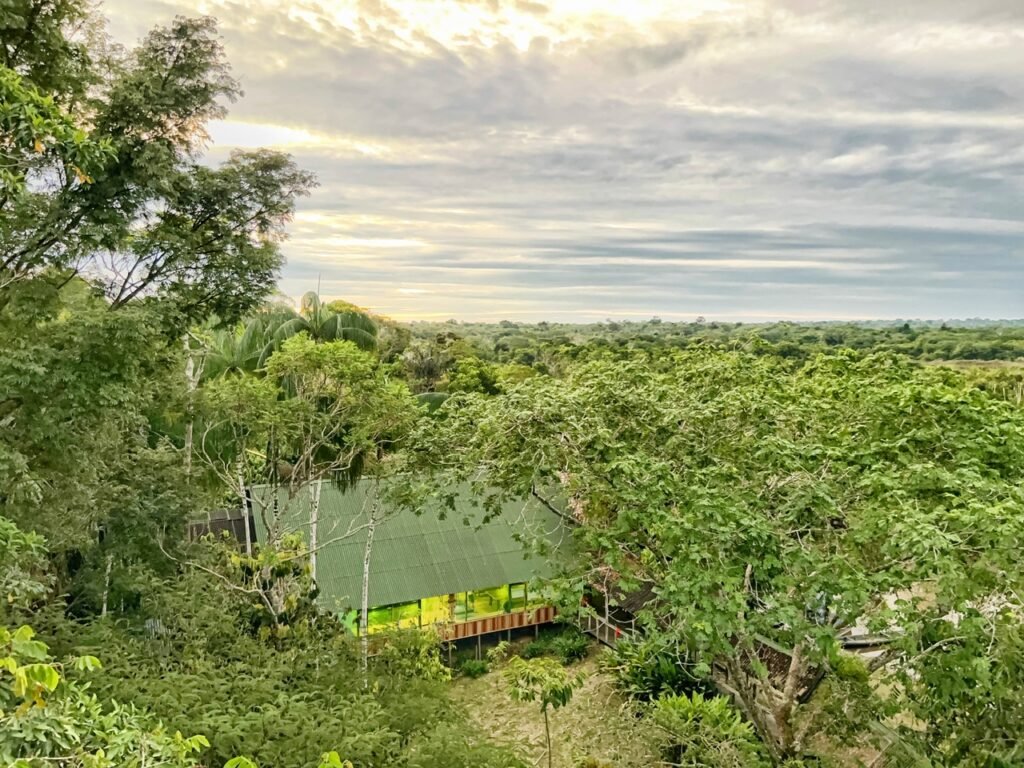
The view from the top of the mirador tower in Palmarí. On the final night we had a beer up here with our guides to celebrate our time. Make sure to tip them! They appreciated it so much!
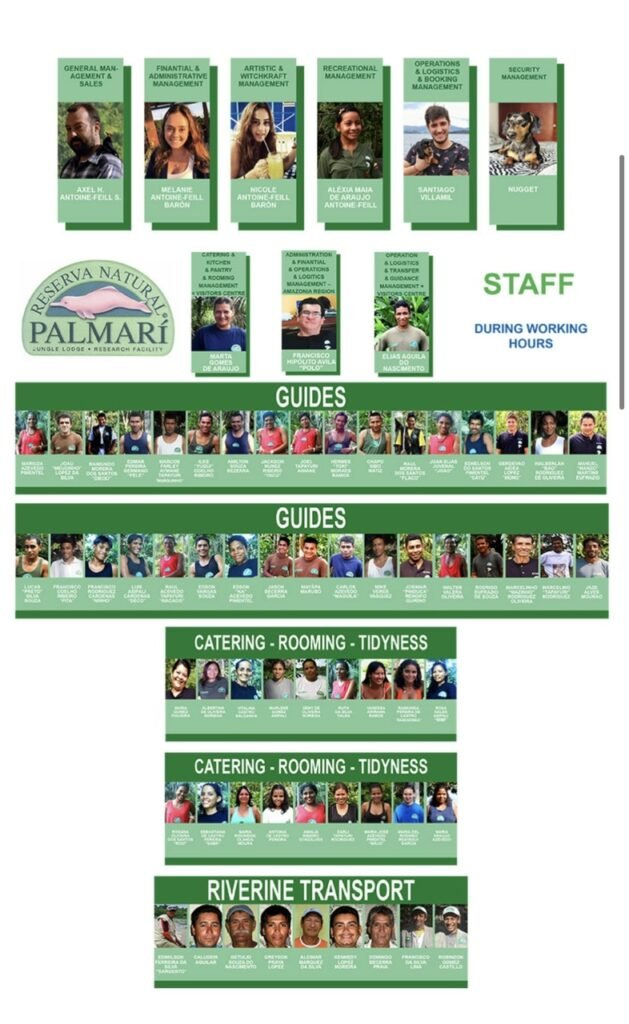
What appears to be a very outdated photo of the massive staff at Palmarí.
The Activities
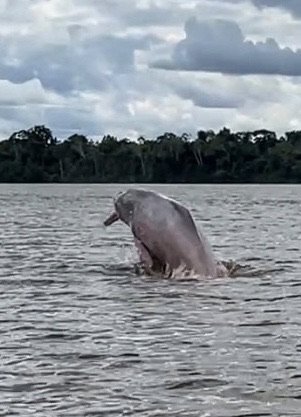
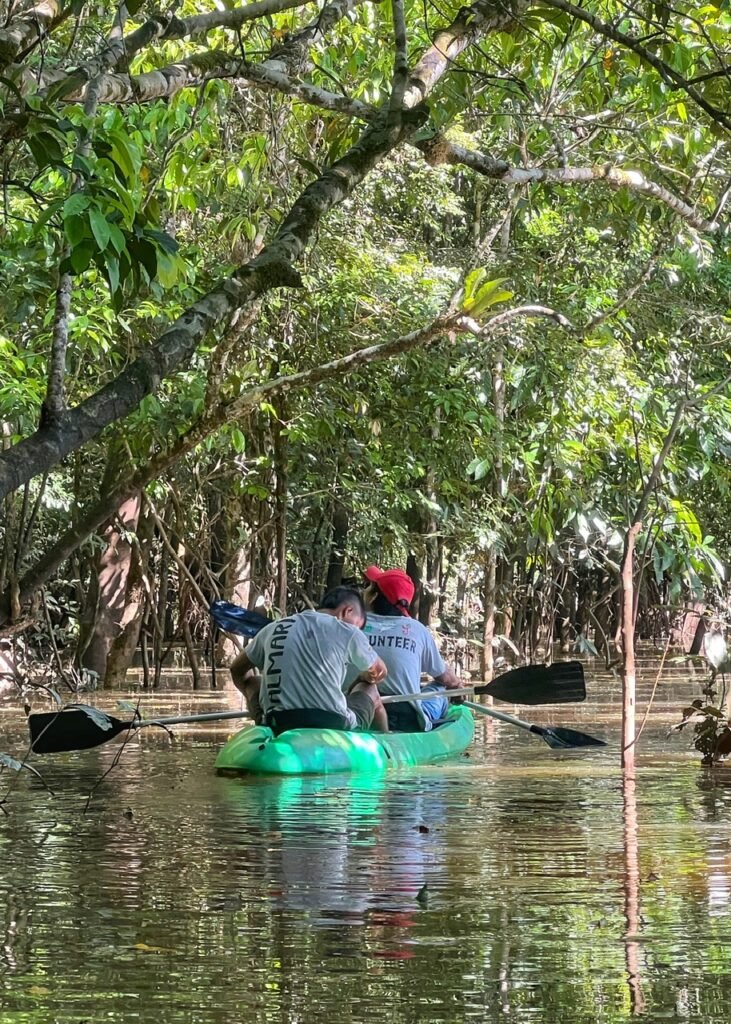
Included in our daily fee at Palmarí was a private guide for the entire time of our stay, as well as a massive list of jungle and water activities of which we only got to do a fraction of.
The assortment was unbelievable! Activities ranged from kayaking, stand up paddle boarding, wake boarding, jungle walks, pink dolphin viewing, swimming, an overnight in the jungle (next post, our fav!), temporary huito tattoos, craft making, village visits, sport (pirana) fishing, blow gun shooting, birding, caiman viewing, and visits to all types of sites around the reserve and area.
Fortunately, many of these activities could be attained as a “twofer.” For example, on our kayaking trip, through the flooded forest and then out into the open river, we were astounded to become entirely encompassed by pink boto river dolphins, which takes the grey sea dolphins we’re accustomed to seeing to a whole new level. These dolphins are quite common throughout the Amazon and are here….history.
Of course, catching them in action is a bit of a challenge. We probably tried to film and observed them playing peekaboo near our kayak for an hour and these were the best shots we managed. That said, the experience is not something that could ever be captured in photos or videos. It must be lived to really understand how beguiling being surrounded by unicorn-like pink dolphins can be.
We also got a twofer with our guides, Hugo and Marcos, because Marcos, Hugo’s 19-year-old nephew is in training to become a guide himself. They led us through the flooded forest in a magical ride that lasted about three hours.
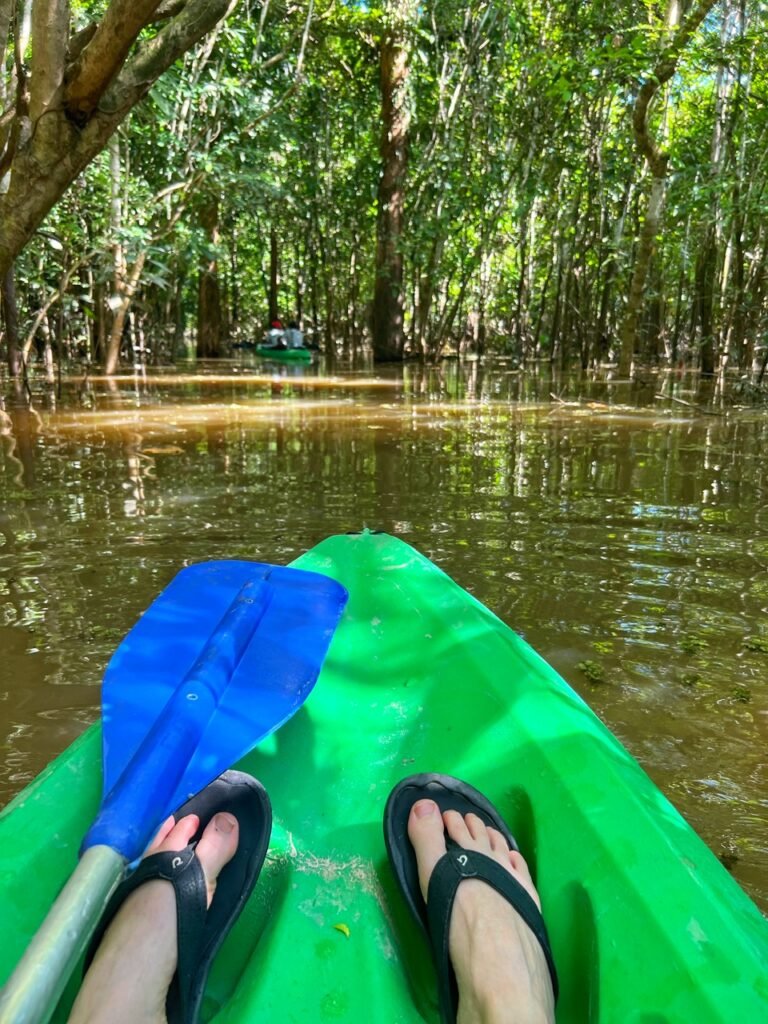
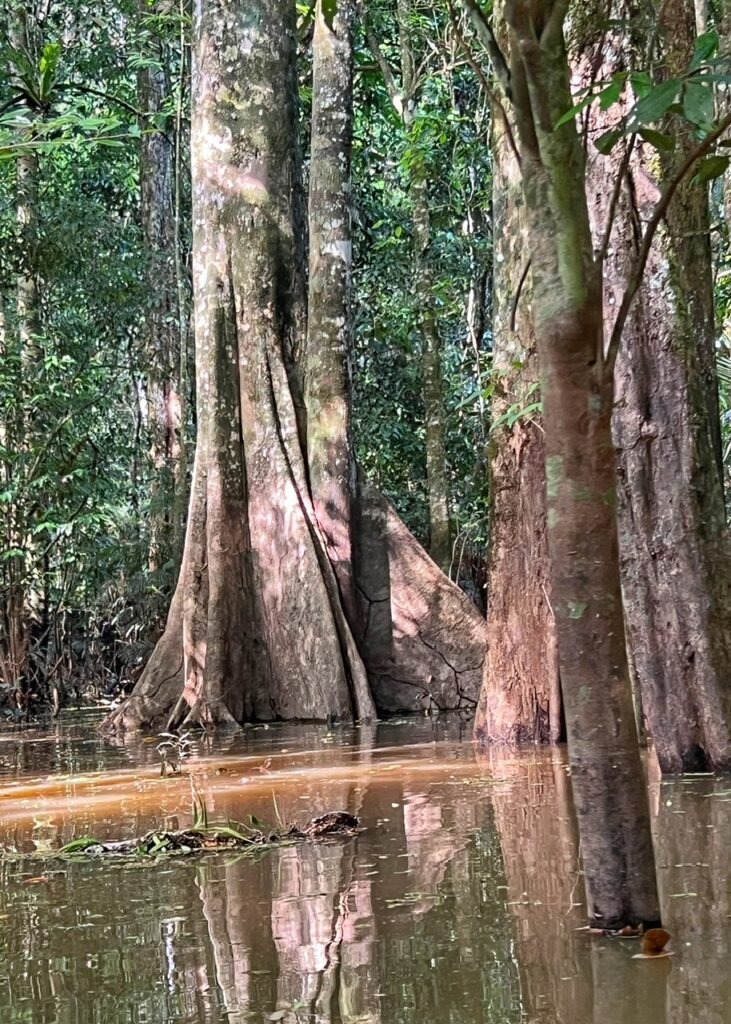
This was incredibly idyllic and relaxing, as we floated alongside sacred Ceiba trees.
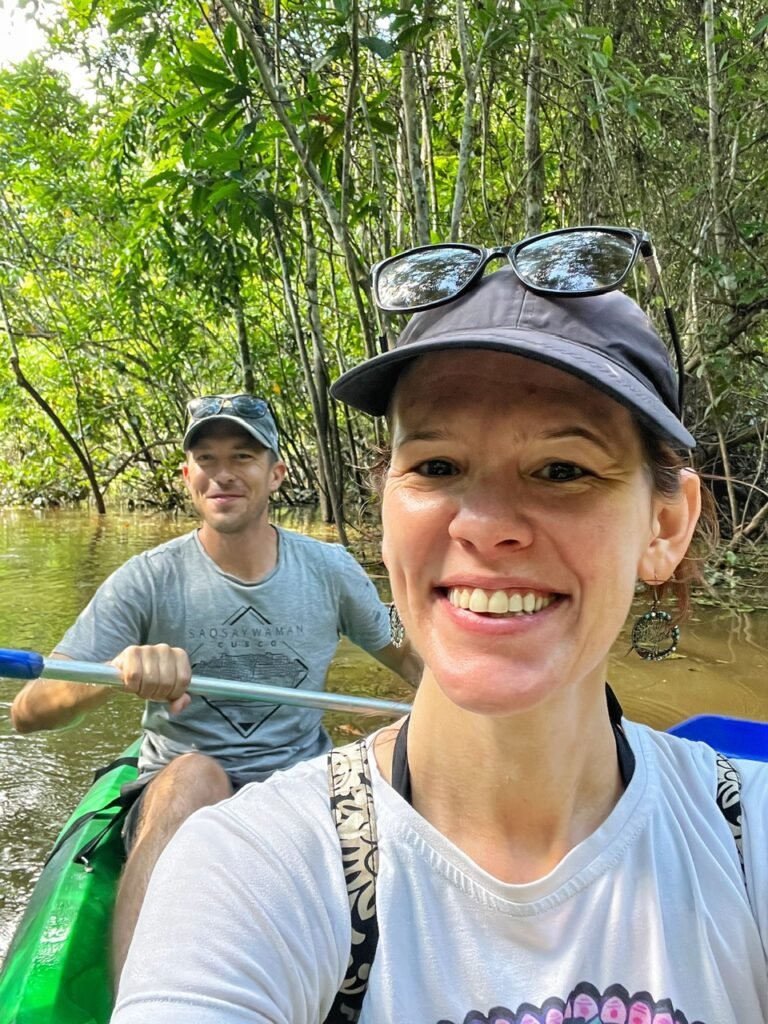

Obligatory kayak selfie.

In some places, the branches got so low we had to float through by completely crouching over in our kayak.
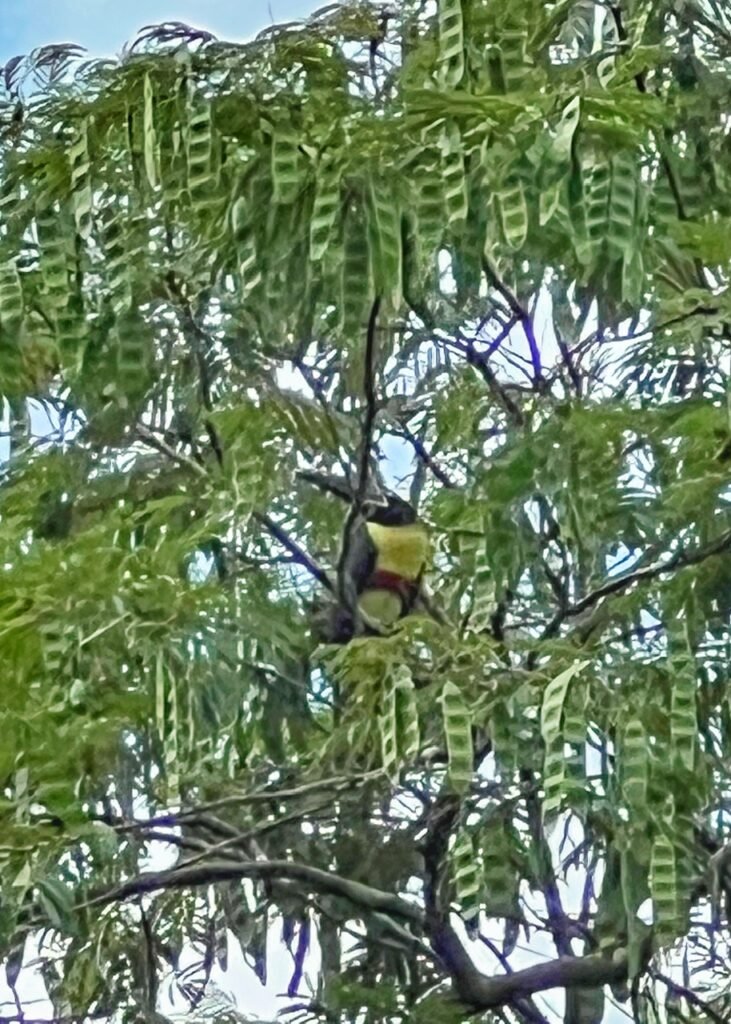
Toucan!! Yay!

And of course the action in the jungle is not only by day. In fact, the best adventures, we discovered, happen at night. In this instance, we joined a boat full of people going caiman “hunting,” (which of course does not mean hunting in the literal sense.)
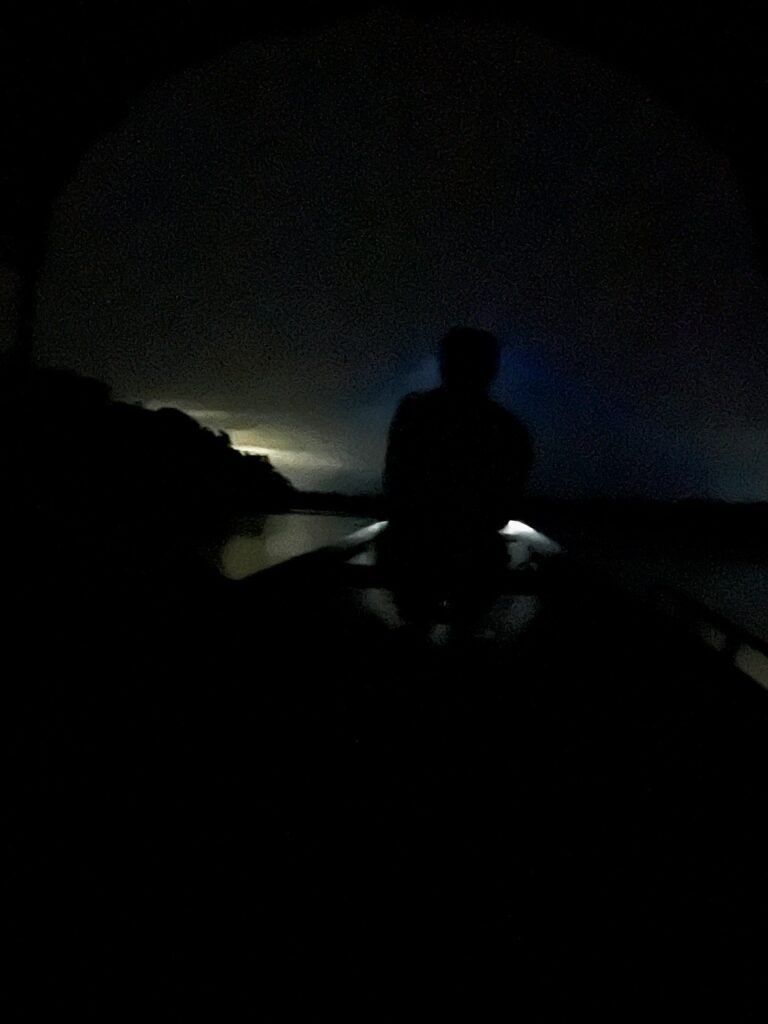
It was pretty epic to be on the silent water in the starlight as the guide stood on the bow casting his radiant headlamp across the horizon like a beaming lighthouse.
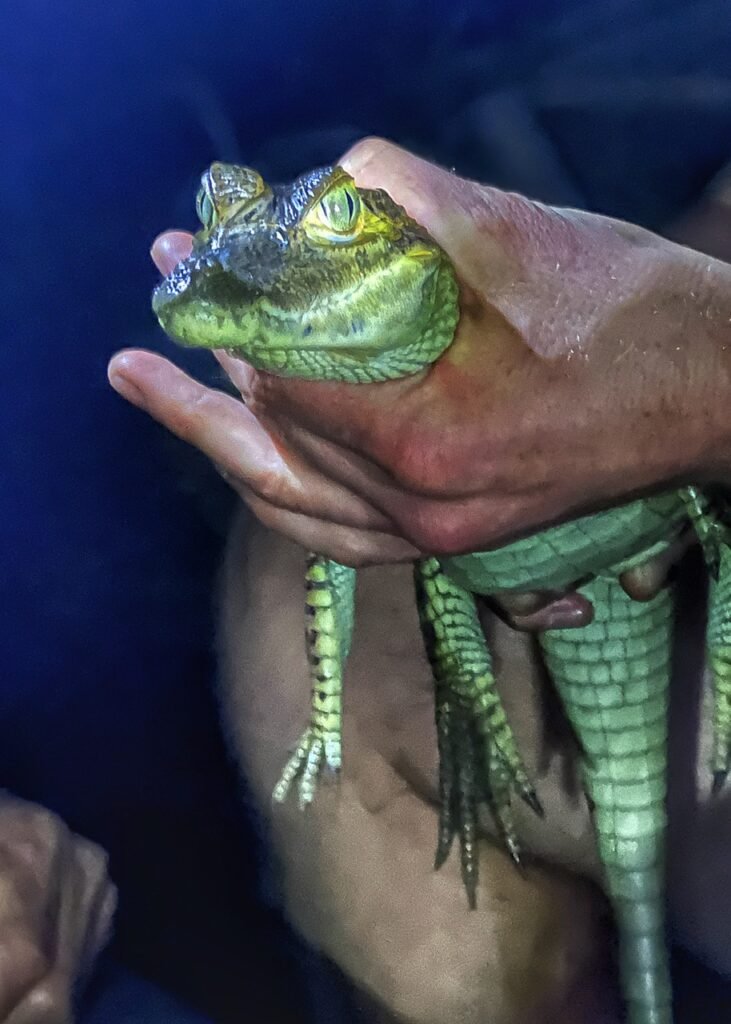
It was then quite engrossing to watch him pull into a flooded forest, (absurdly) remove his shoes and pants, and step onto the mushy earth to retrieve a completely invisible (to us) caiman baby of about a year old.
The caiman is of course related to an alligator and live throughout the Amazon. The largest type, the black caiman can grow to 6 meters (20 feet) so this little guy seemed like a chihuahua by comparison.
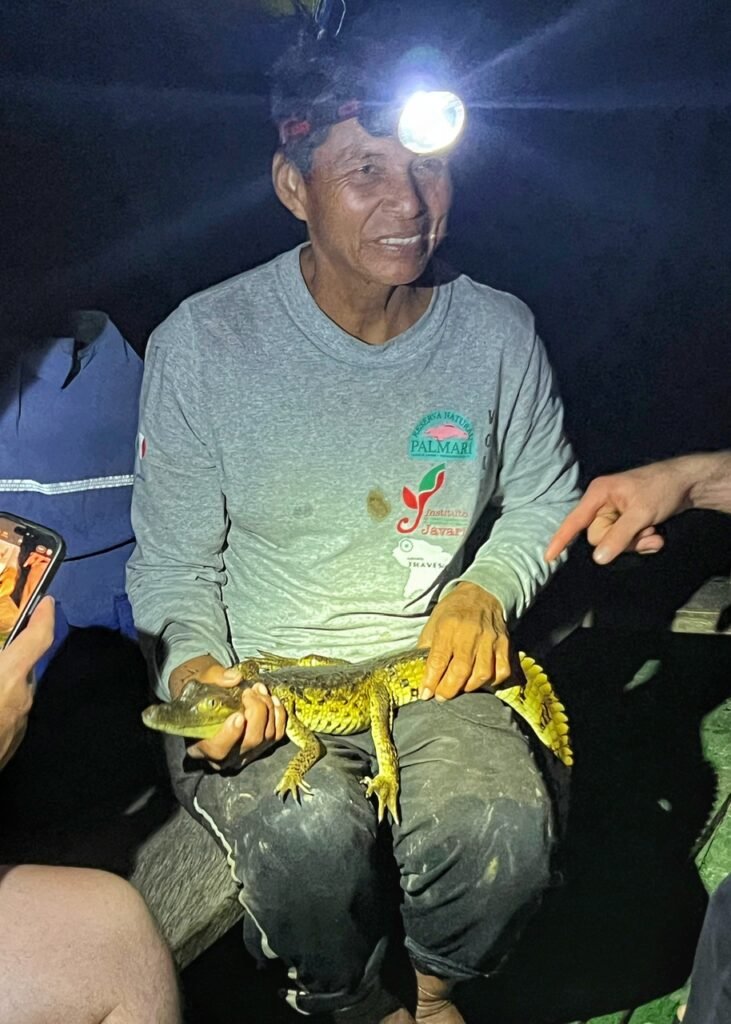
A few people touched and/or held the caiman before the guide released him back in the water. It was cool to see him so close but we had mixed feelings on whether or not this was ethical treatment. The little guy did look a bit scared. 🐊😢 On the ride, one of the volunteers also showed us pictures of an anaconda baby that had been caught a few days prior (by baby we mean at least five feet (1.5 meters)

The night sky on the Amazon was just beautiful.
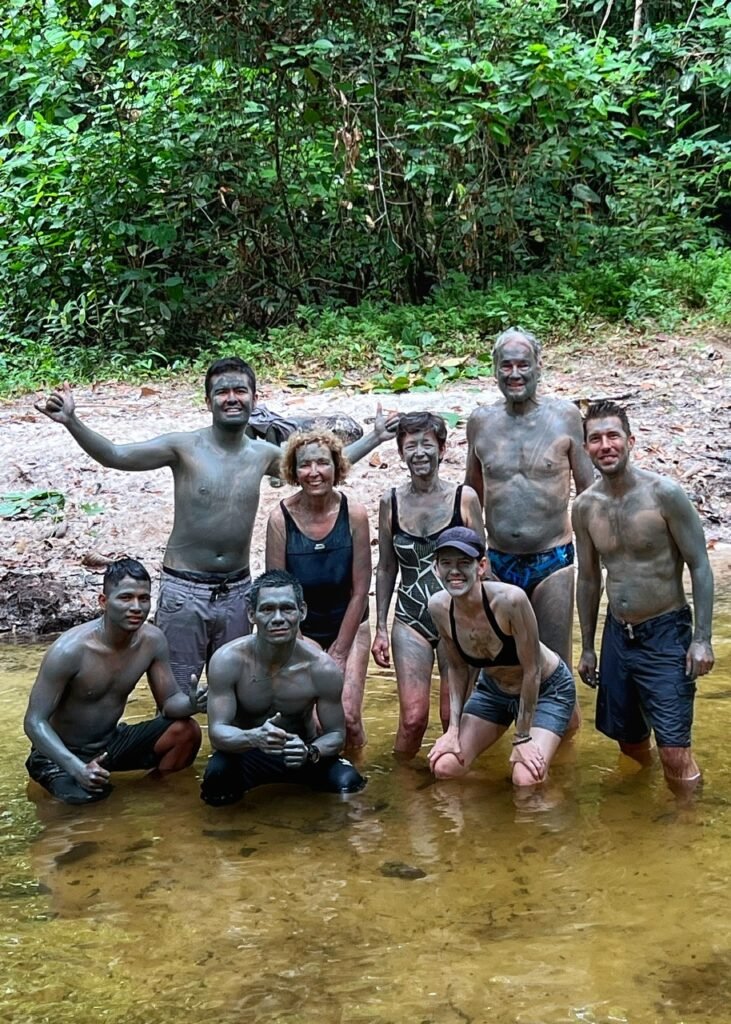

On another occasion, we took a jungle walk with a group of people to a swimming/mud “spa” hole. On the way, we encountered a rubber tree which surprisingly looked like camouflage.
According to Lonely Planet, Amazonian indigenous groups had long used sap to make things, but elsewhere the material was difficult to use out of the humid rainforest until Charles Goodyear developed vulcanization in 1842 making it more durable. In 1876, the Brits smuggled 70,000 rubber tree seeds from the Amazon and before long their territory of Ceylon (now Sri Lanka) was saturated with them. Following this, the price of latex plummeted through the years. Fearful of foreign annexation of the Amazon, Brazil developed a “use it or lose it” policy in the 1970’s which led to massive destruction of our world’s “lungs.” The rate of deforestation in the 1980’s was equivalent to more than a football field per minute for a decade.
The effects of climate change continue since 2005 with extreme droughts and floods, each breaking previous records. Our planet is in serious danger because of these actions.

Arriving to our swimming hole….
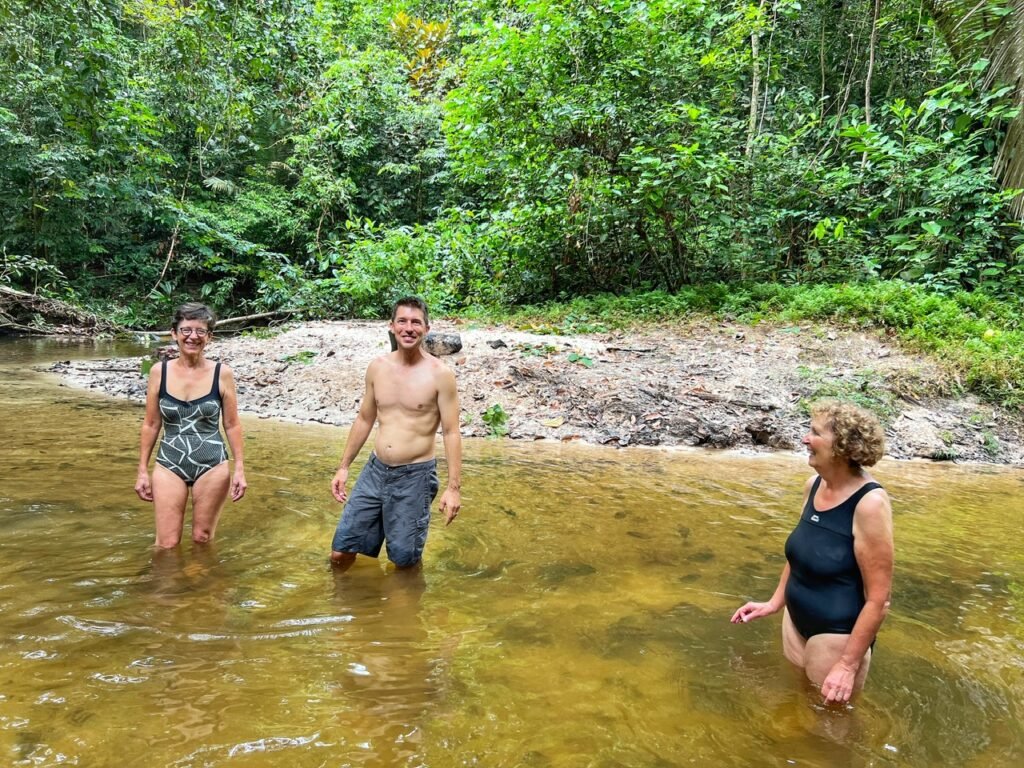
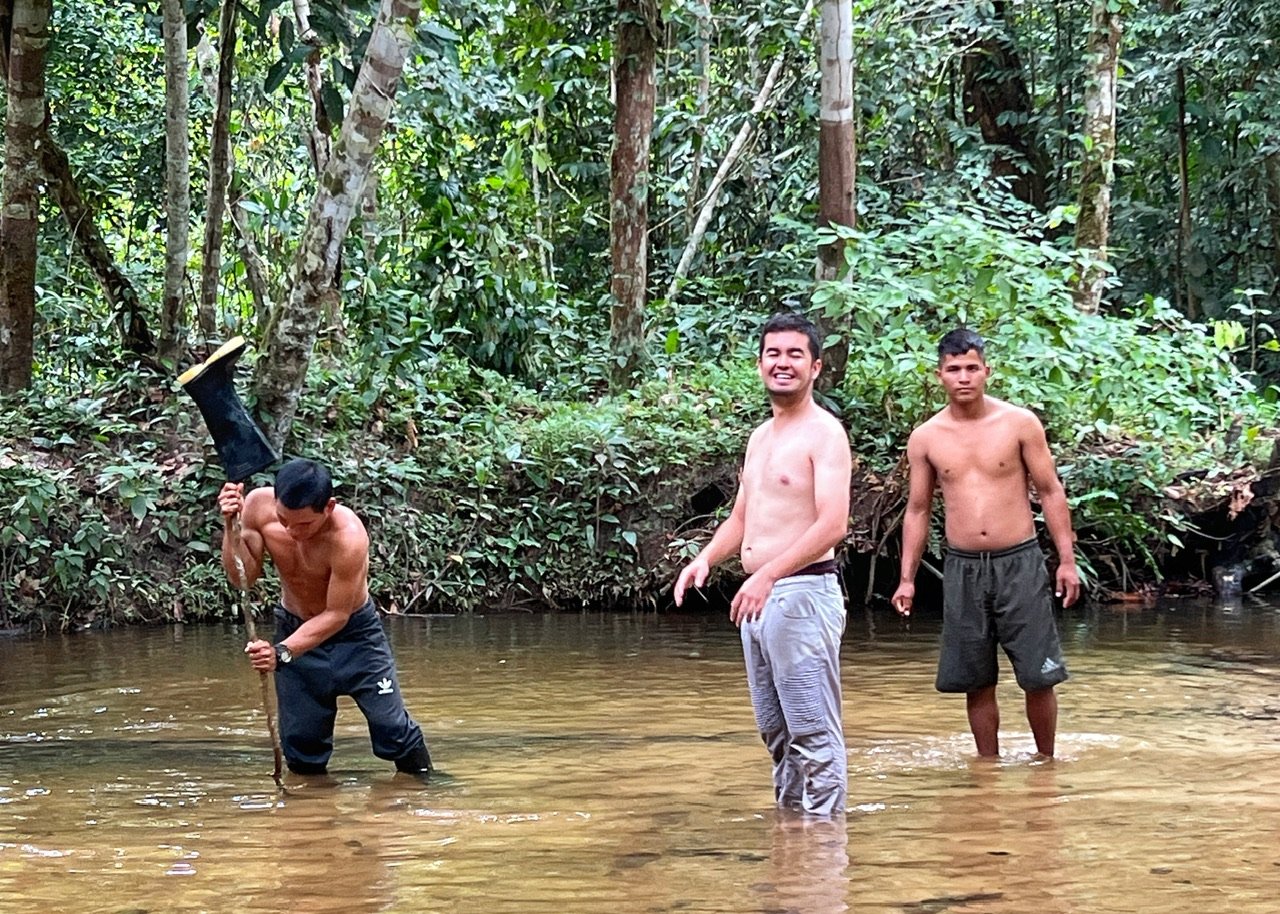
…which we enjoyed with our new friends from Seattle and the UK. As well as the guides, and friendly volunteer Jonathan, who is Colombian, although clearly is from Bogota and not Amazonas.
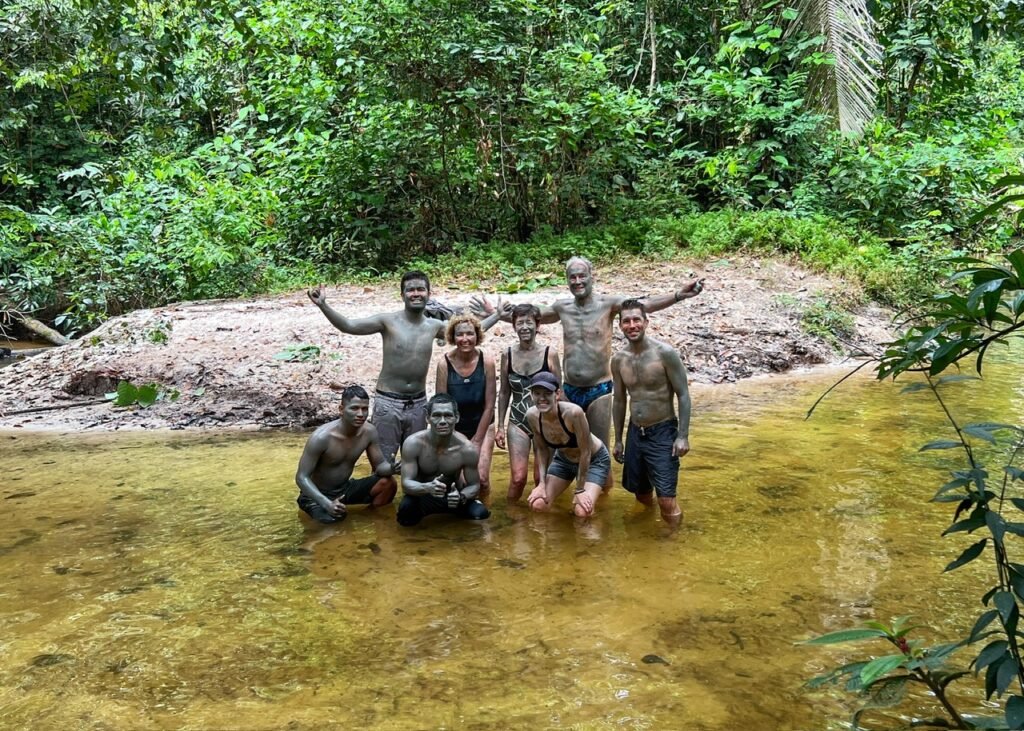
Our whole group after delving into the therapeutic mud embedded just under our feet.
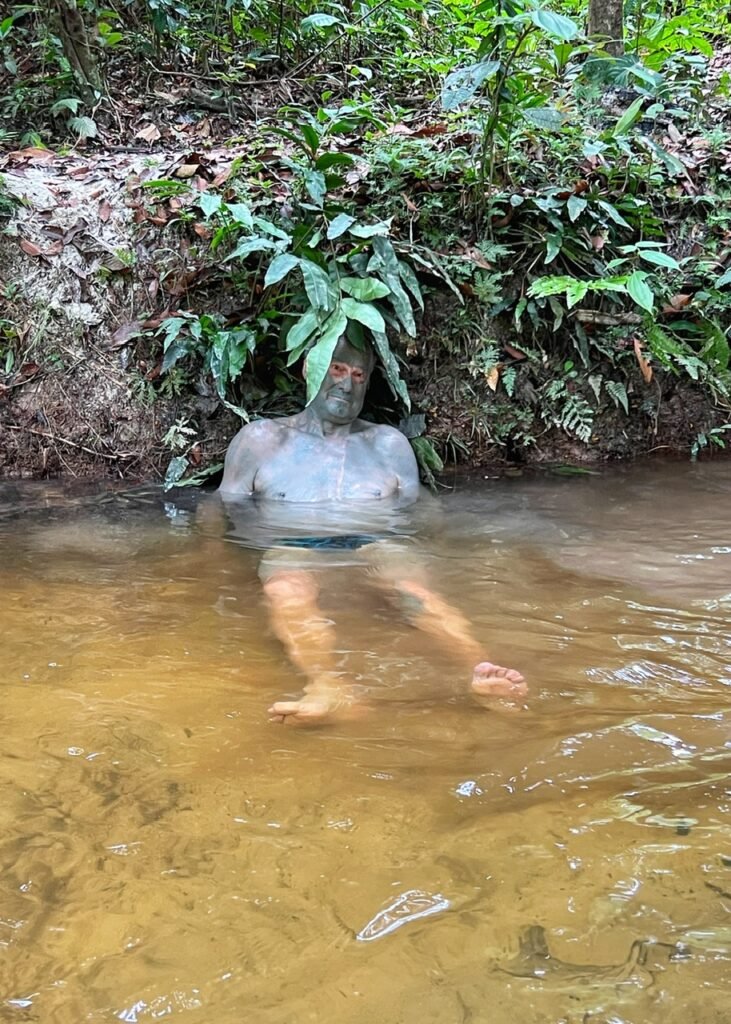
Kip from Seattle playing Rambo.
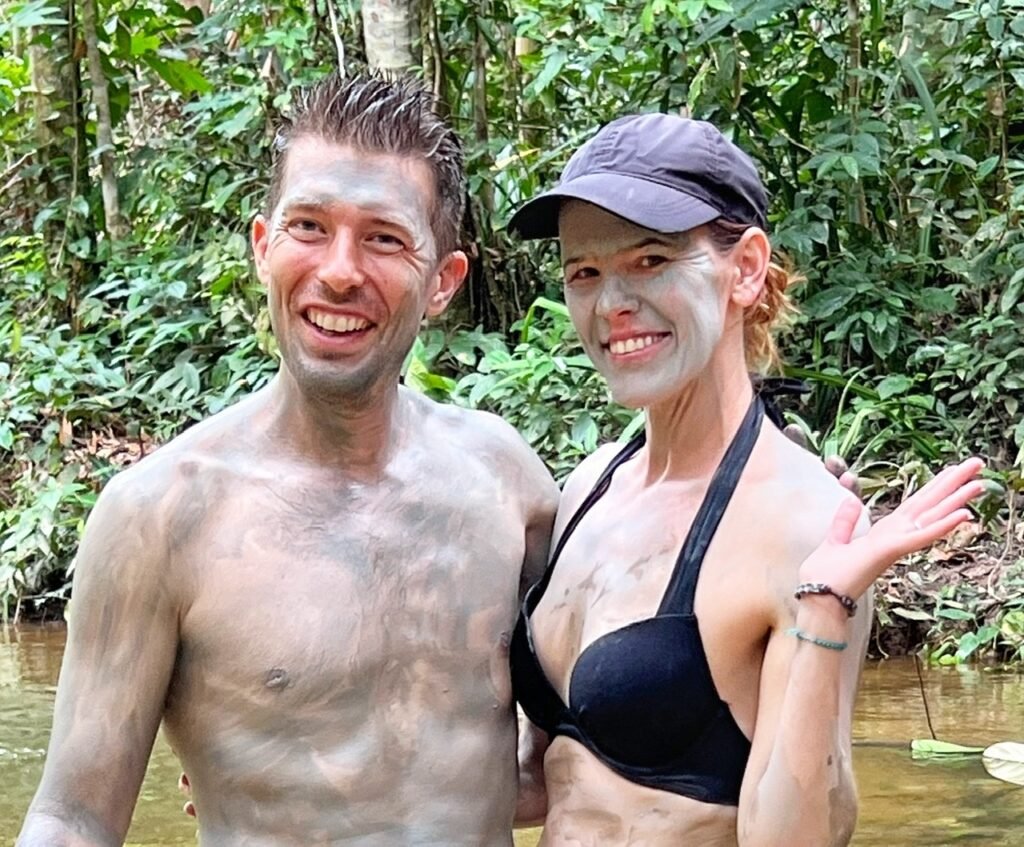
The secret to staying young? This is somehow our fifth time we’ve slathered ourselves in natural mud in the last few months. 🤣
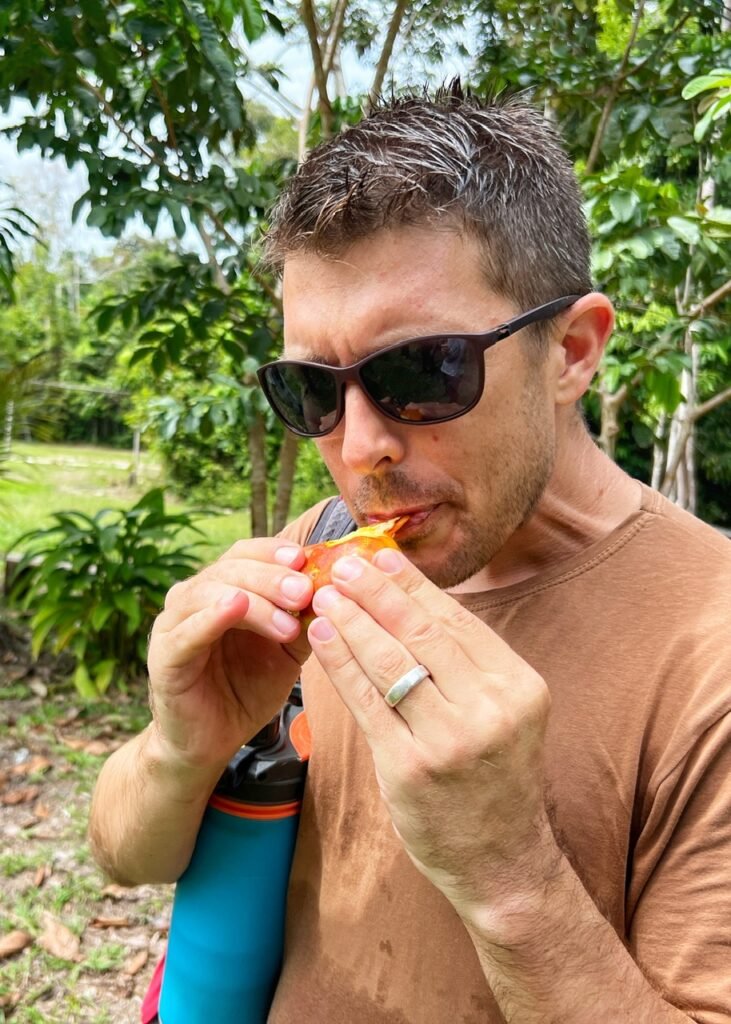
Greg, always the weird fruit explorer, jumped at the chance to try yet another weird jungle fruit which our group passed around like a joint. It was not one of the better ones.
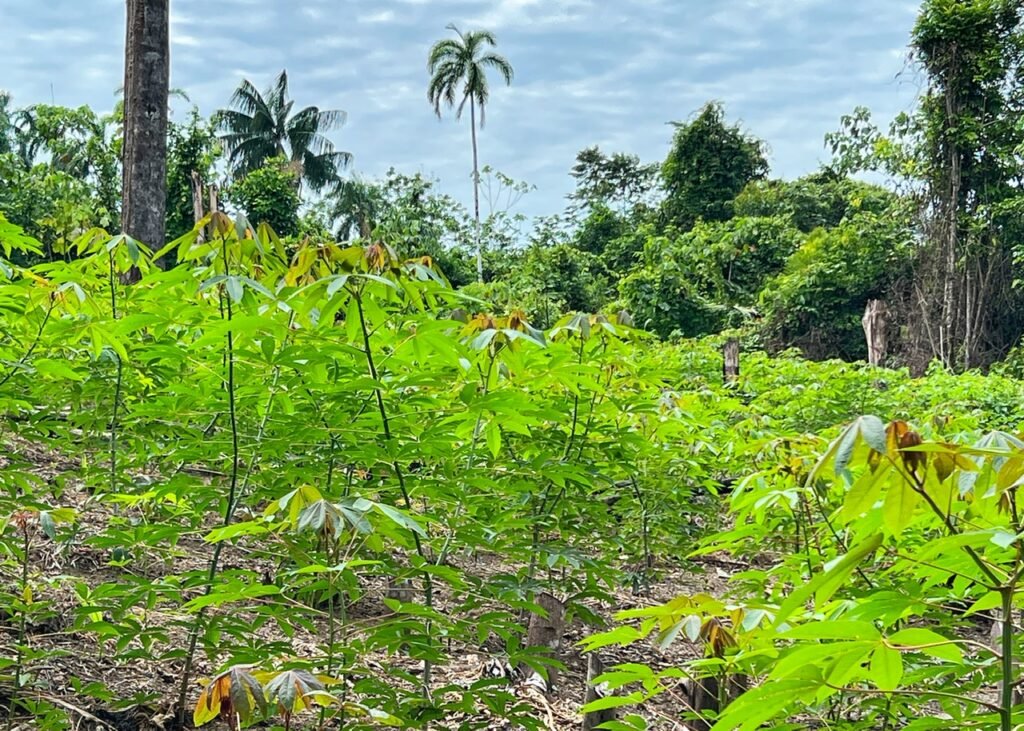
Fields of newly planted yucca.
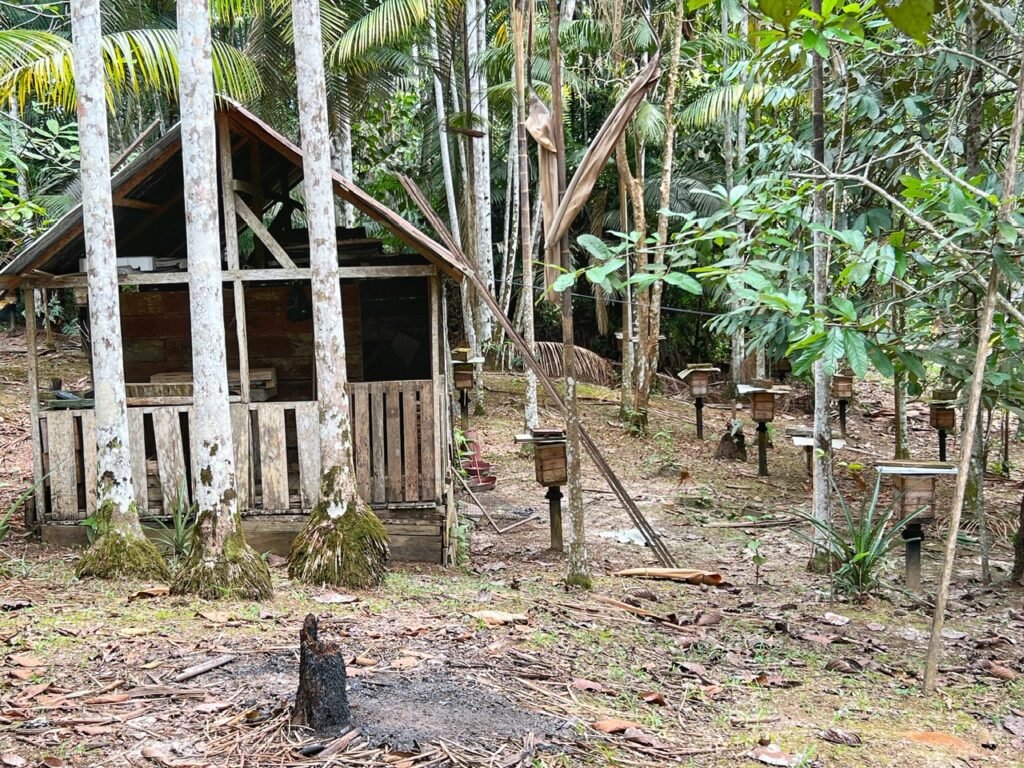
Walking through the village of Palmarí, next to the reserve. The boxes you see are interestingly bee boxes for making honey.
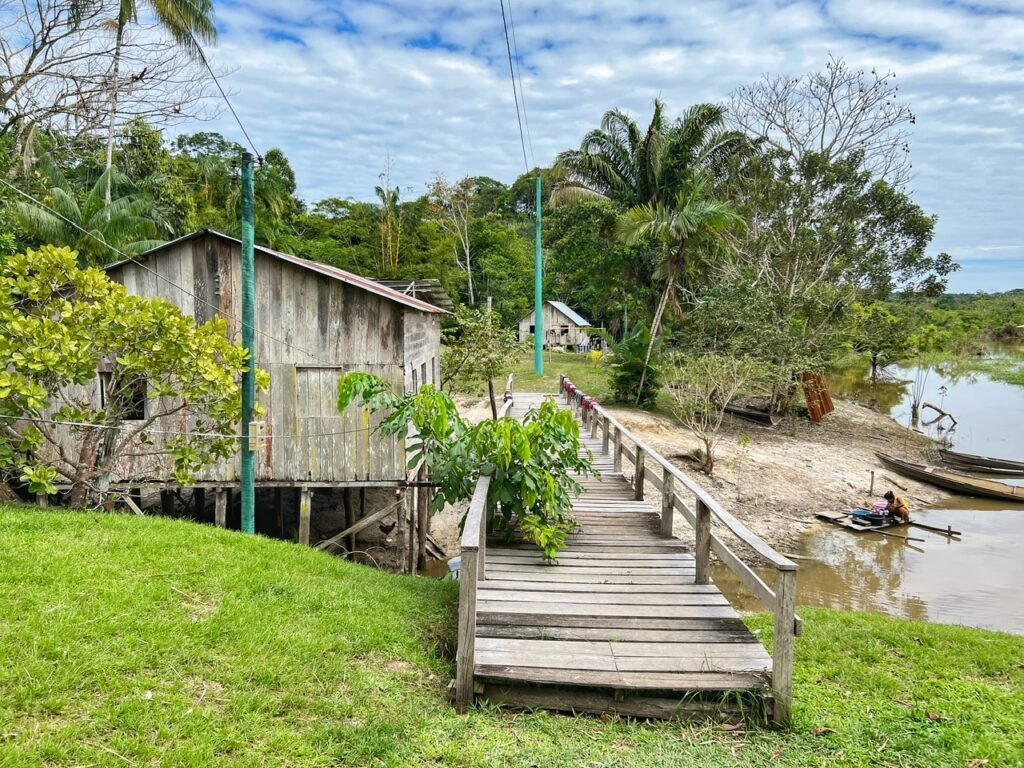
More of Palmarí.
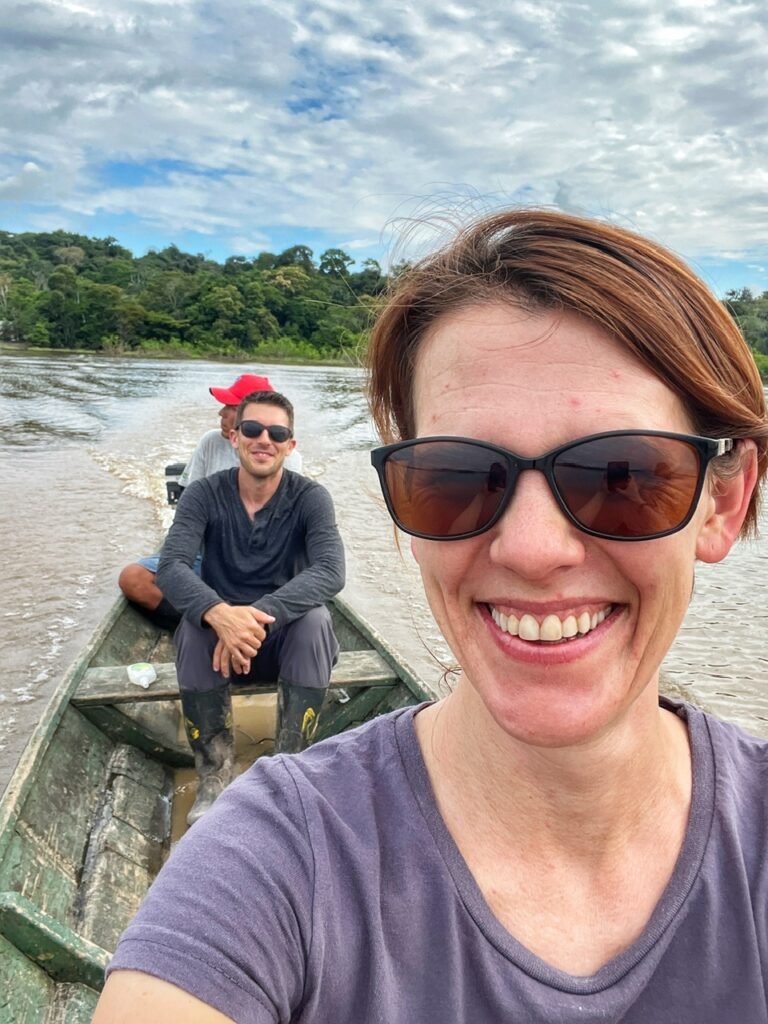
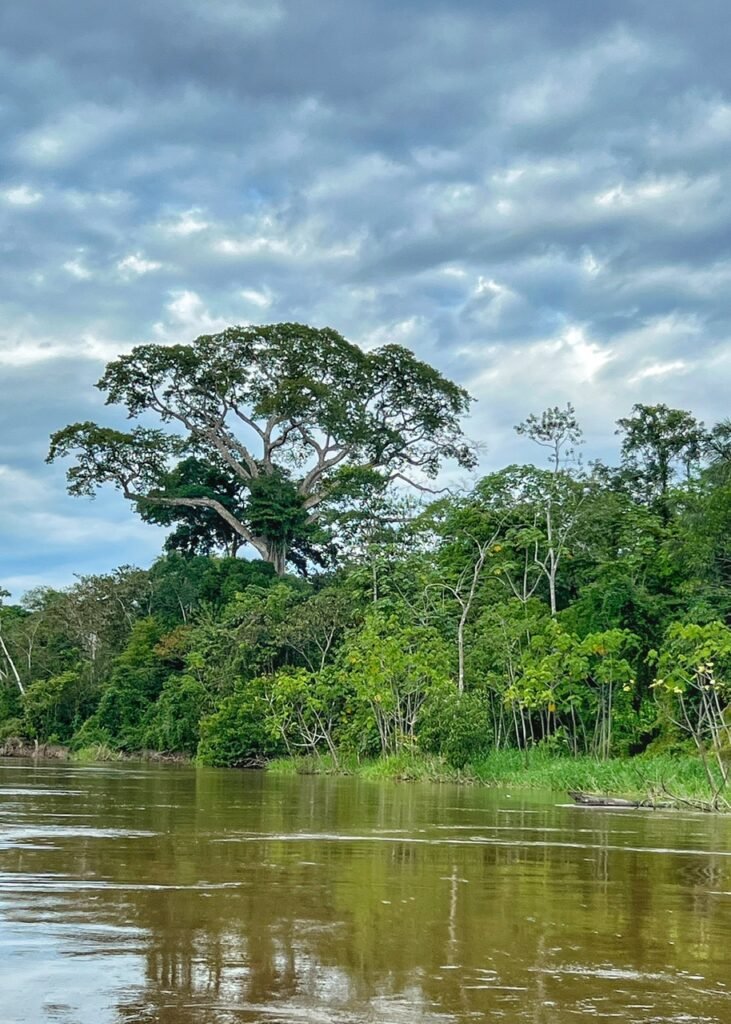
On the next adventure we took a small wooden motor boat about an hour round trip to cast our eyes on the supposed biggest ceiba tree in the Amazon, more than 500 years old, which towered like the most beautiful skyscraper ever over the surrounding forest.
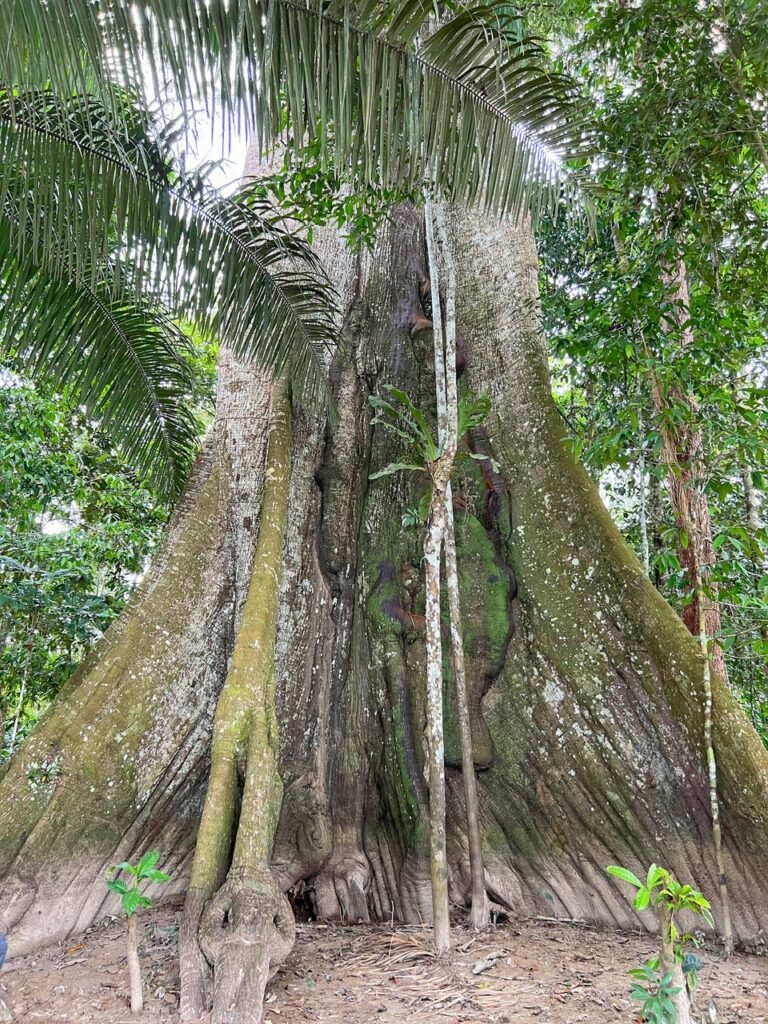

The ceiba tree, or giant kapok, is considered sacred by many indigenous peoples throughout Central and South America. It’s one of those things that makes you feel small and insignificant when standing under it.

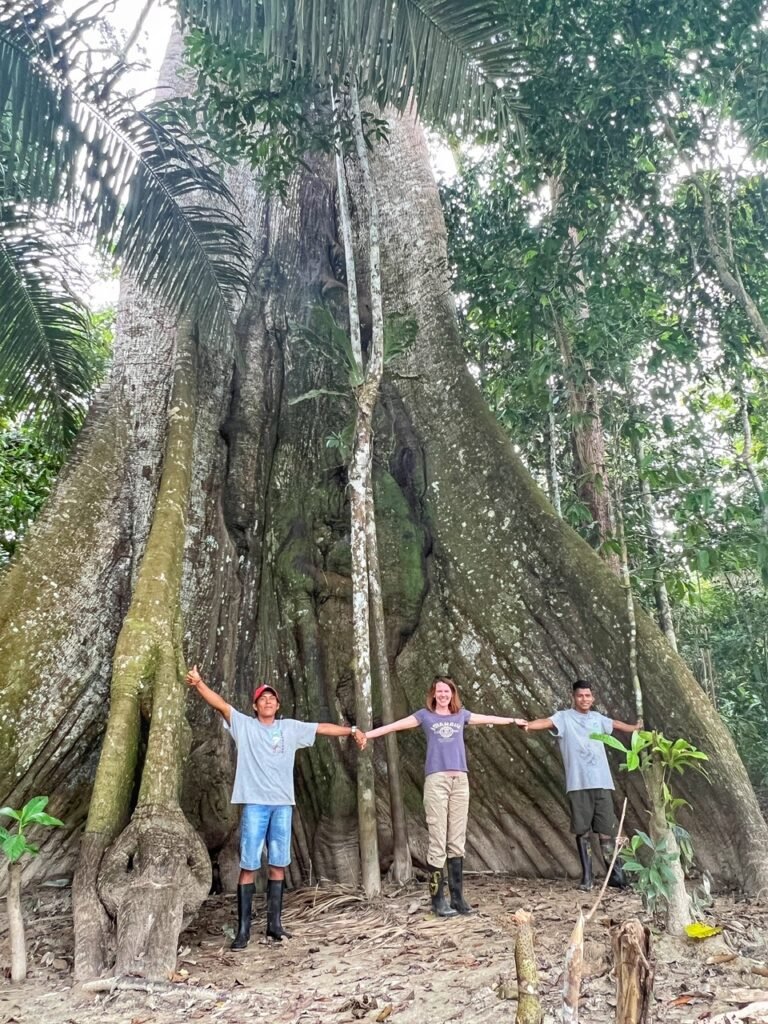
Sacred or not, unfortunately many of them have been deforested. The wood is primarily used in plywood manufacturing, but also for making boxes and crates, and for lightweight joinery material. 😬 Mandy tried to demonstrate the monstrosity of the tree with a little help from our guides.
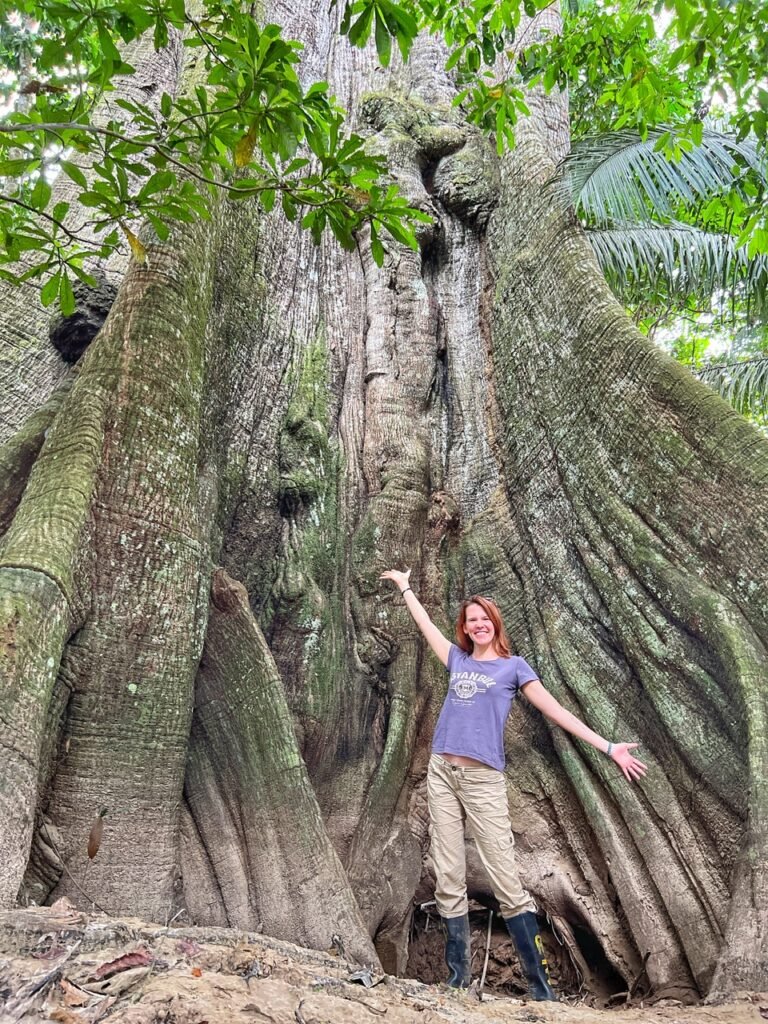
We’ve seen the redwoods, and this was equally as jaw-dropping, if not more.
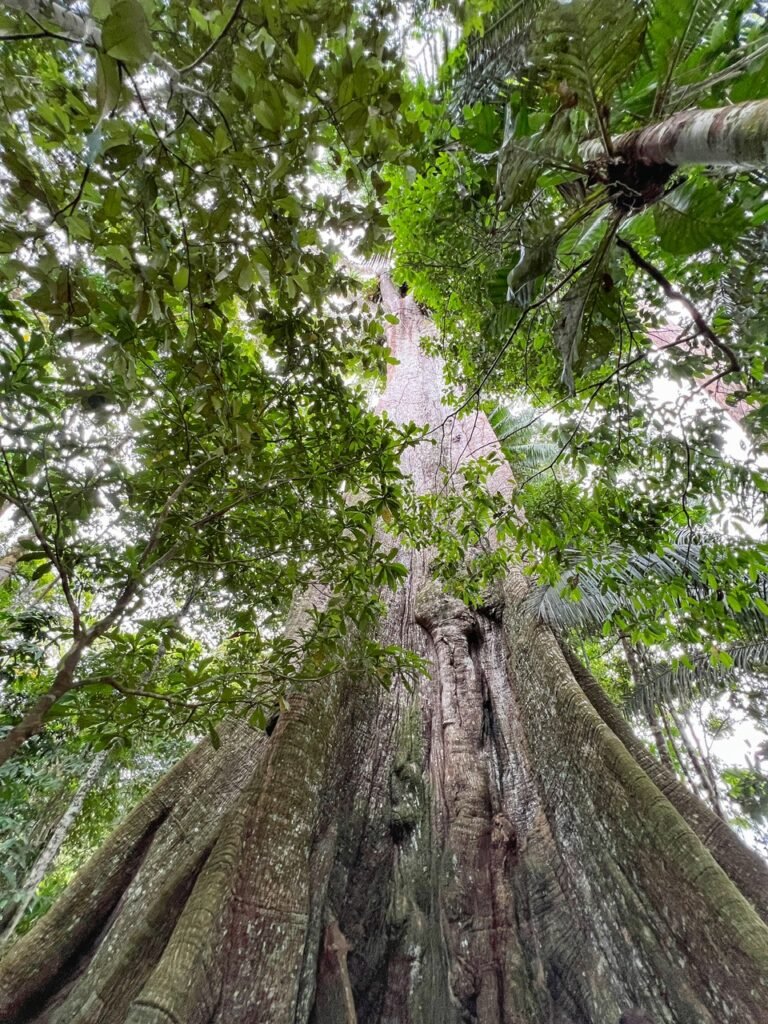
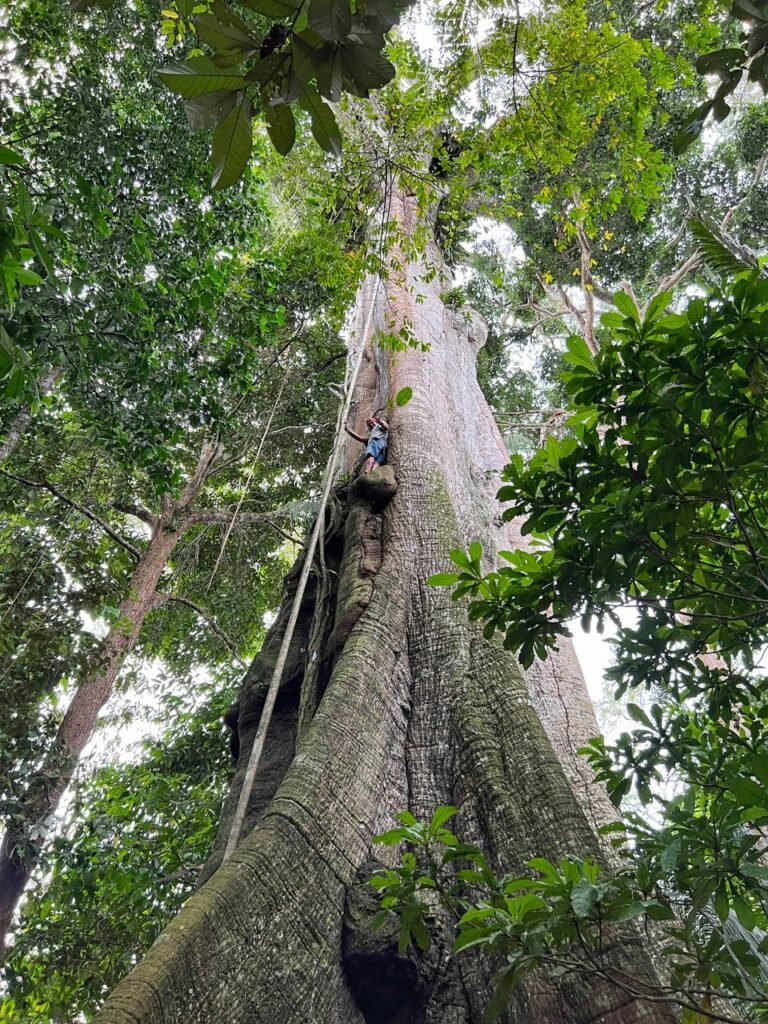
Especially when out of the blue, your moderately fit looking 35-year-old guide starts scaling a vine like Tarzan on steroids.

On the way to and fro, Mandy had a nice charla, chat, getting to know about the family of Marcos, and his dream of being a guide, and eventually traveling to far away places like Argentina, Spain, France, and Russia. His biggest dream was seeing snow. (Marcos is Peruano which made his Spanish way easier to understand than some.)
Overnight in the Jungle

We must admit, over the years we’ve watched way too much of the TV show, Naked and Afraid or “Supervivencia Al Desnudo” as it’s called lately. Thus, due to visions of this show and mosquitoes realistically, we actually debated whether or not to do the overnight camping trip in the Amazon at Palmarí. Not doing it would have been a serious mistake as it ended up being one of the most unreal experiences of our lives. But over time, we’ve definitely learned, “The walls of your comfort zone are lovingly decorated with your lifelong collection of favorite excuses.”
Thus…always say yes!!!
It began with a fairly easy, but very steamy hike of about two hours led by our warrior guides, Hugo and Marcos. In addition to guiding and pointing out bizarre jungle flora along the way, they proceeded to do all the work of setting up our hammocks (con mosquito nets!), cooking the finest fish of our lives over the fire, and taking us on a night walk.
Marcos (19) was in training to become a guide and had no better mentor than his Tío (uncle) Hugo, 35. Interestingly, even though they were family, Hugo was from the Brazil side and spoke Portuguese as his native language and Marcos from Peru, who spoke Spanish as his first. But together, and with us, of course, they spoke Spanish.

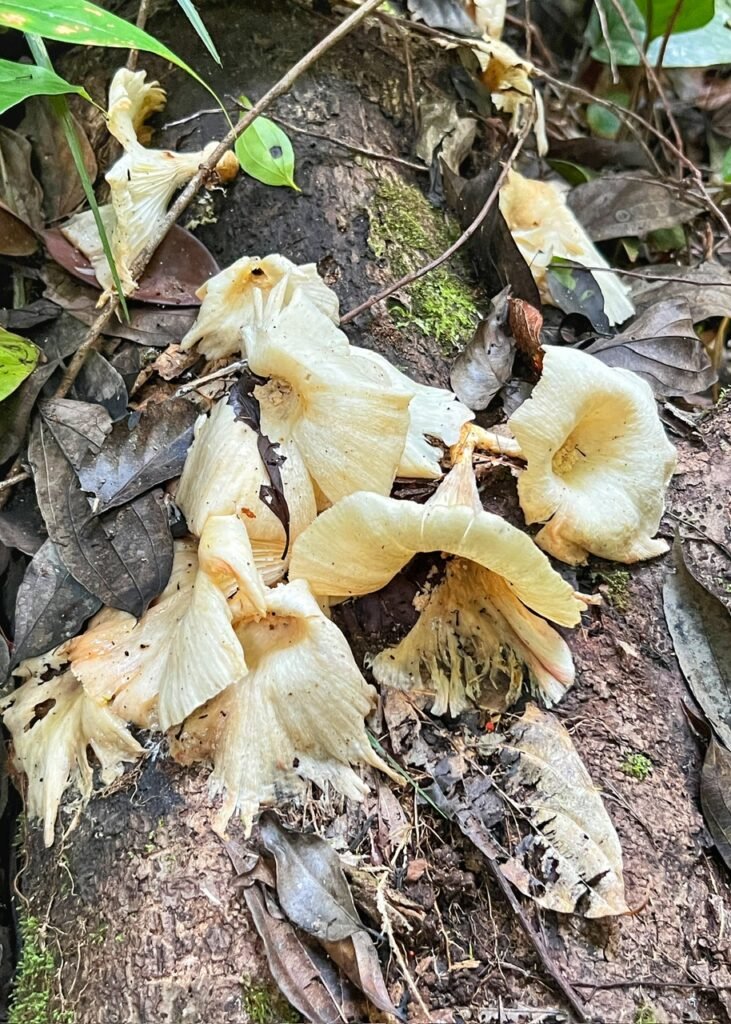
Heading into the real Amazon. These “flowers” are actually a mushroom.
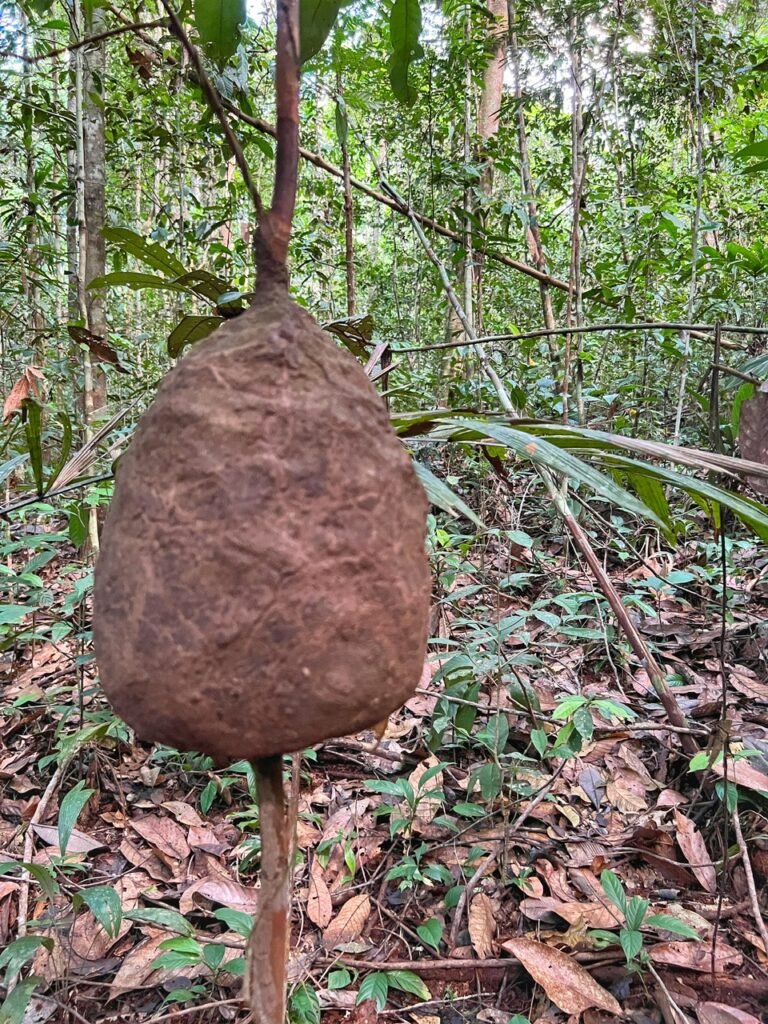
Termite nest
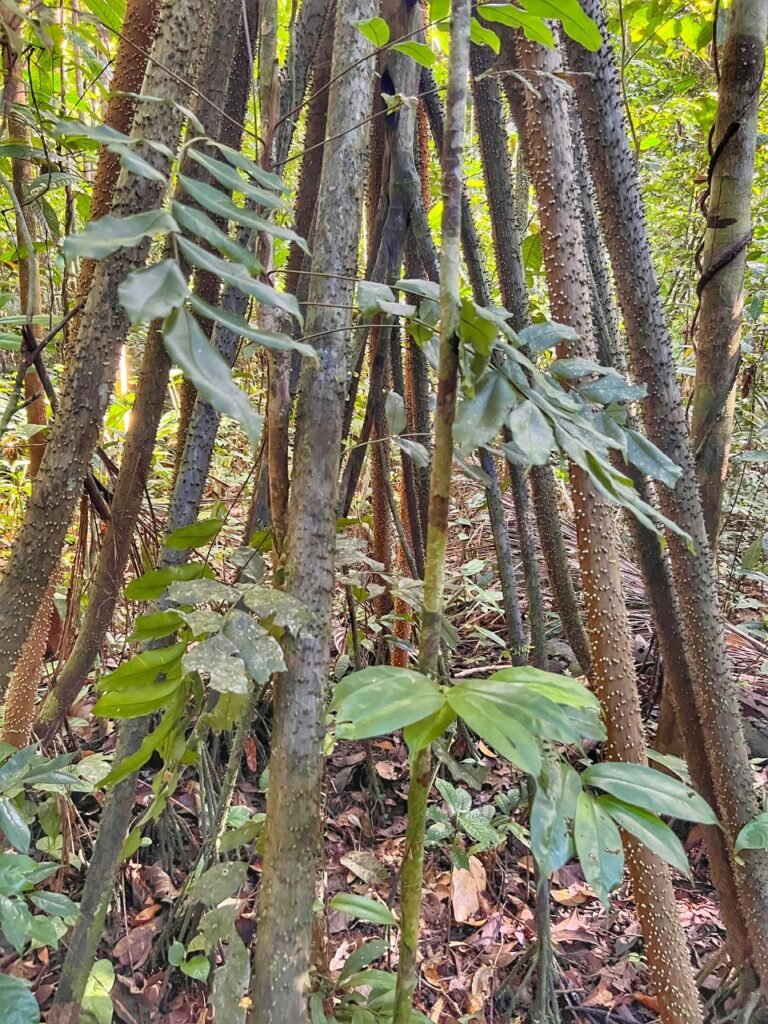

And, an Amazonian torture chamber. These are actually the exposed and spiny roots of the tree above. Eek! Don’t wanna have a run-in with this guy.

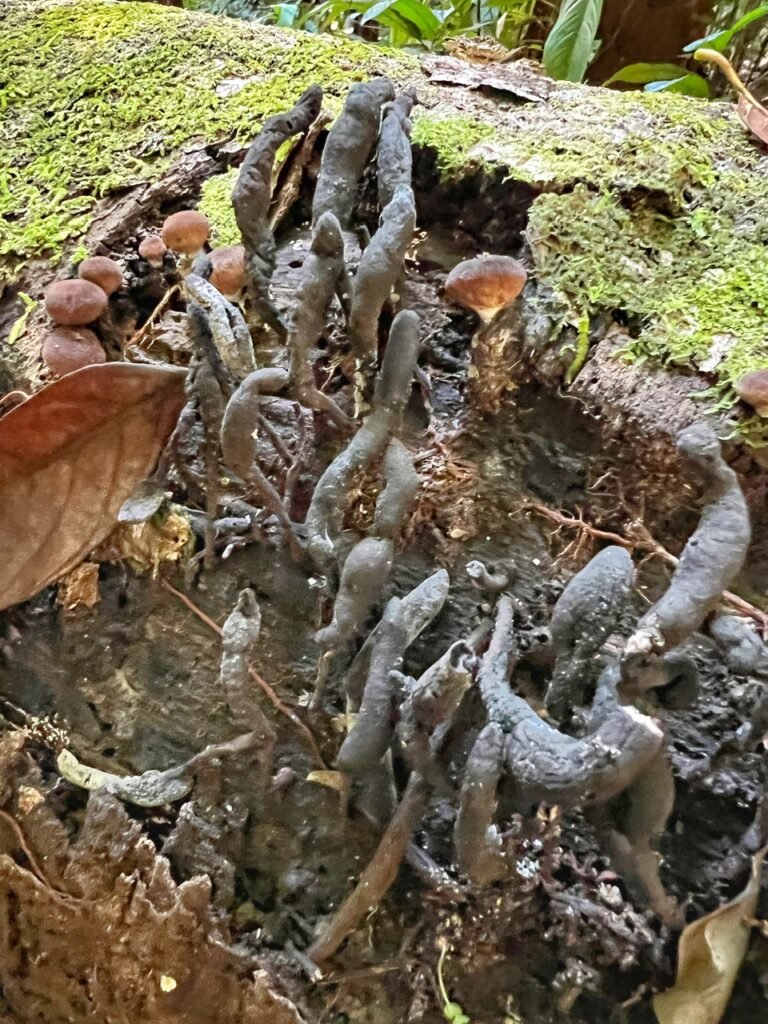
Magic Mushrooms. Initially looking like tarantula legs, we realized quickly it was only a mushroom which looked like gnarled black fingers.
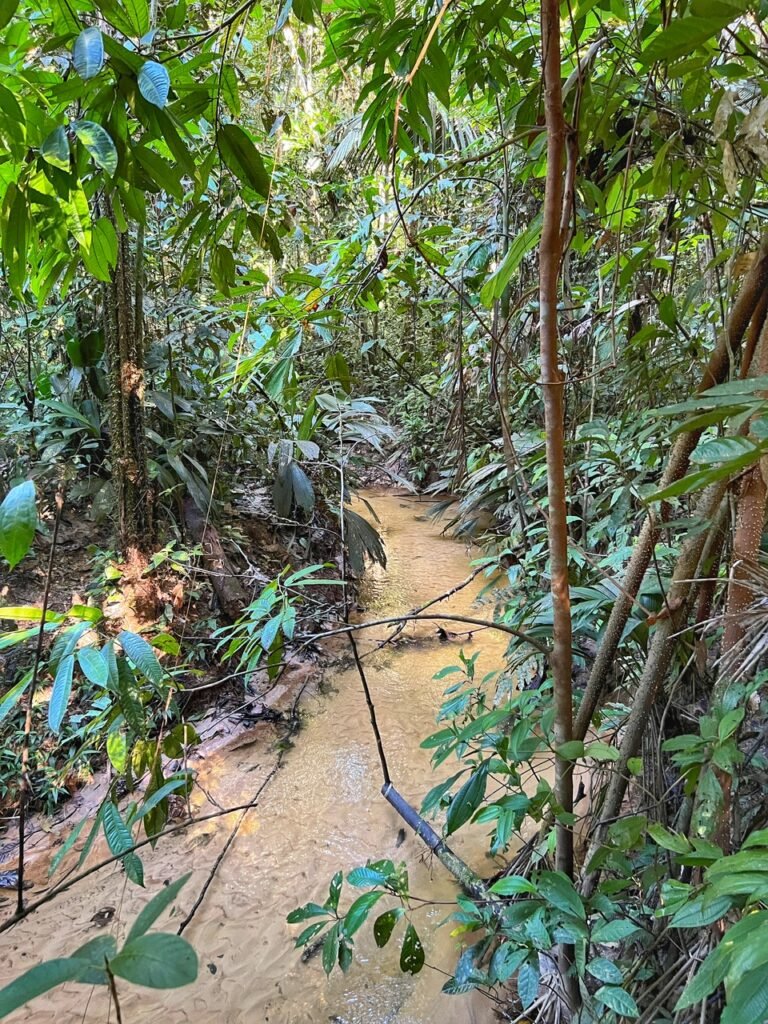
We criss-crossed this creek many times. Considering we were already saturated from head to toe with sweat, even the milky brown water began to look enticing.
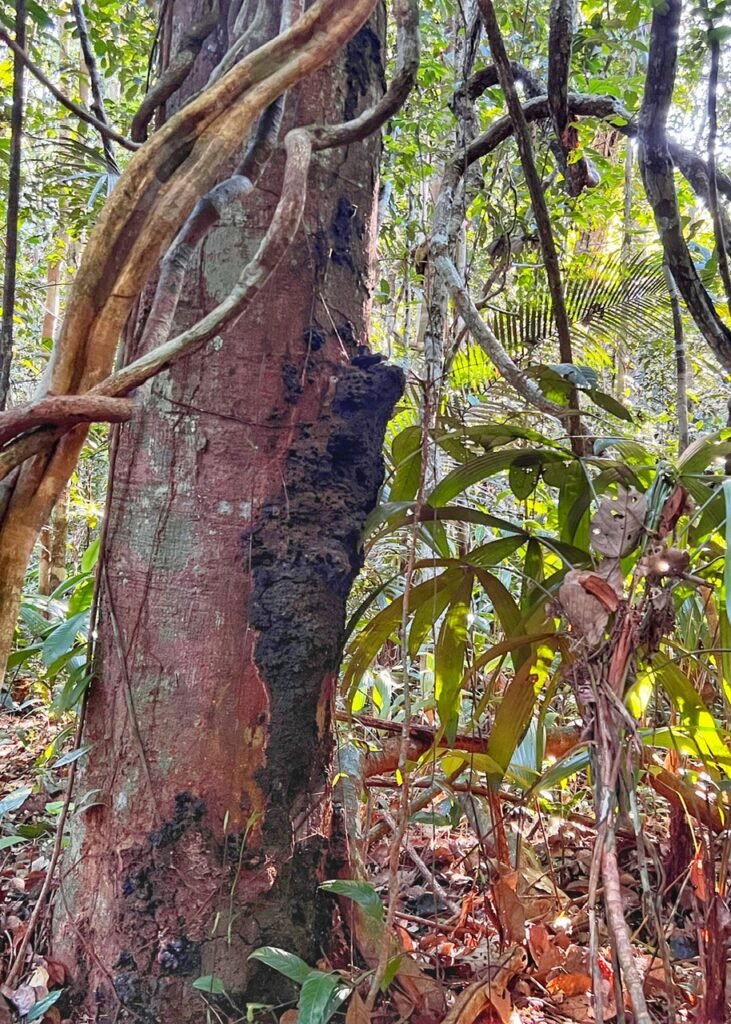
Amazonian flora.

A frog that blends in perfectly with tree bark.

Hugo points out the Harpy egg and nest way over our heads. The reserve has been protecting these eagles for many years.
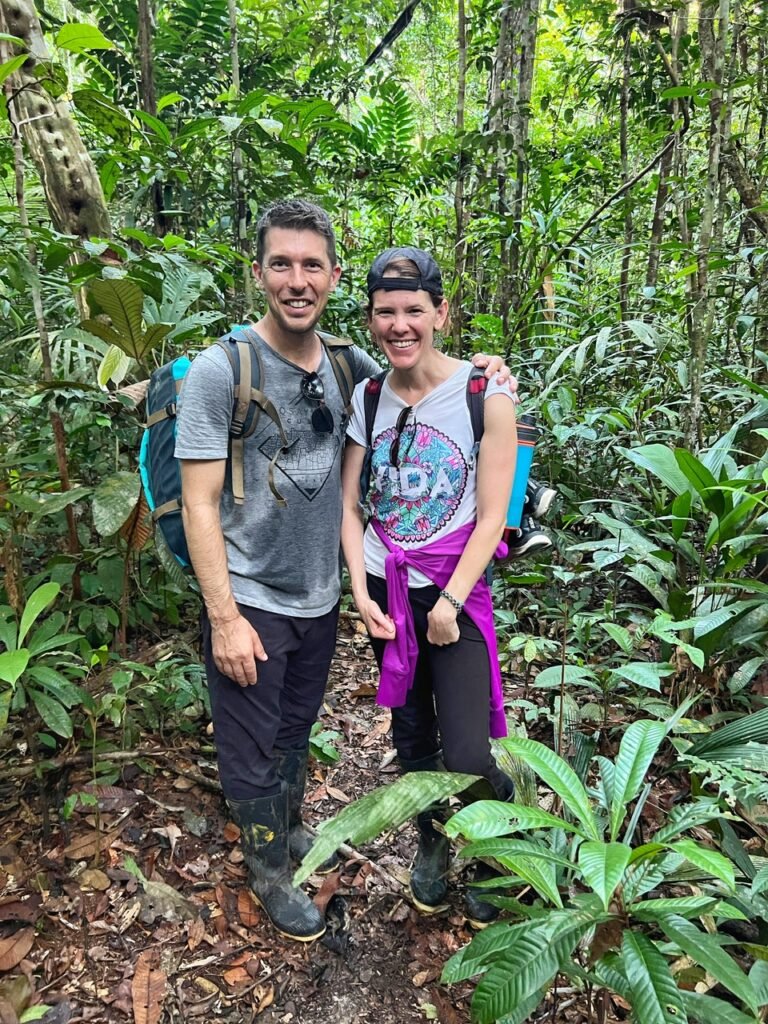
Amazonian chic. You too can achieve this fine look by applying one layer of sunscreen, one layer of Deet, another layer of regular bug spray and six layers of body sweat! Don’t forget to stuff your pants into your sexy rubber boots either. (Provided by the reserve!)
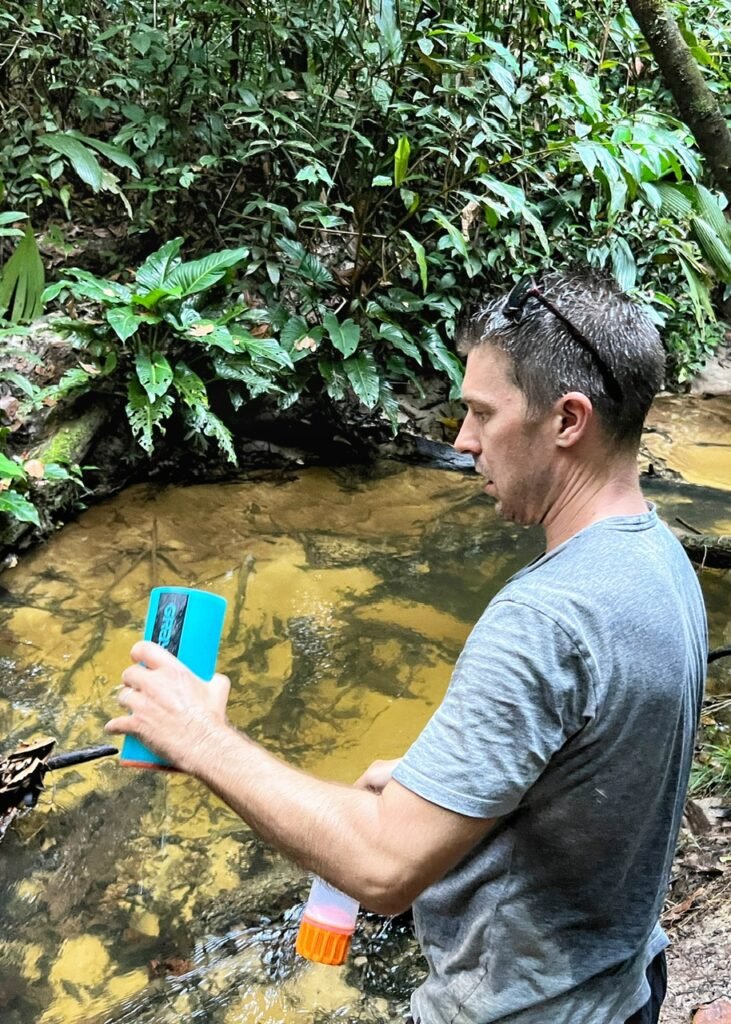
Taking a “bath” in the creek was beyond refreshing (until we reapplied our bug juice). After this, Greg proved our Grayl water bottle filter works by plunging it in Amazonian waters.
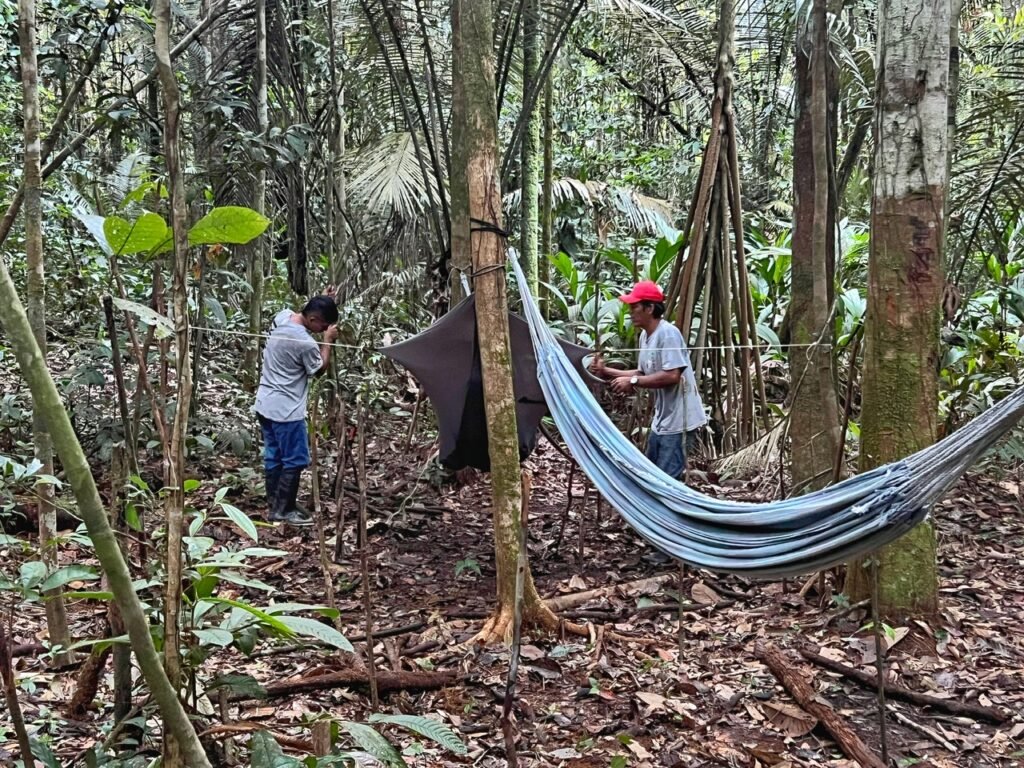

Hugo and Marcos doing all the labor of setting up our camp. We slept in hammocks with completely enclosed bug shields.
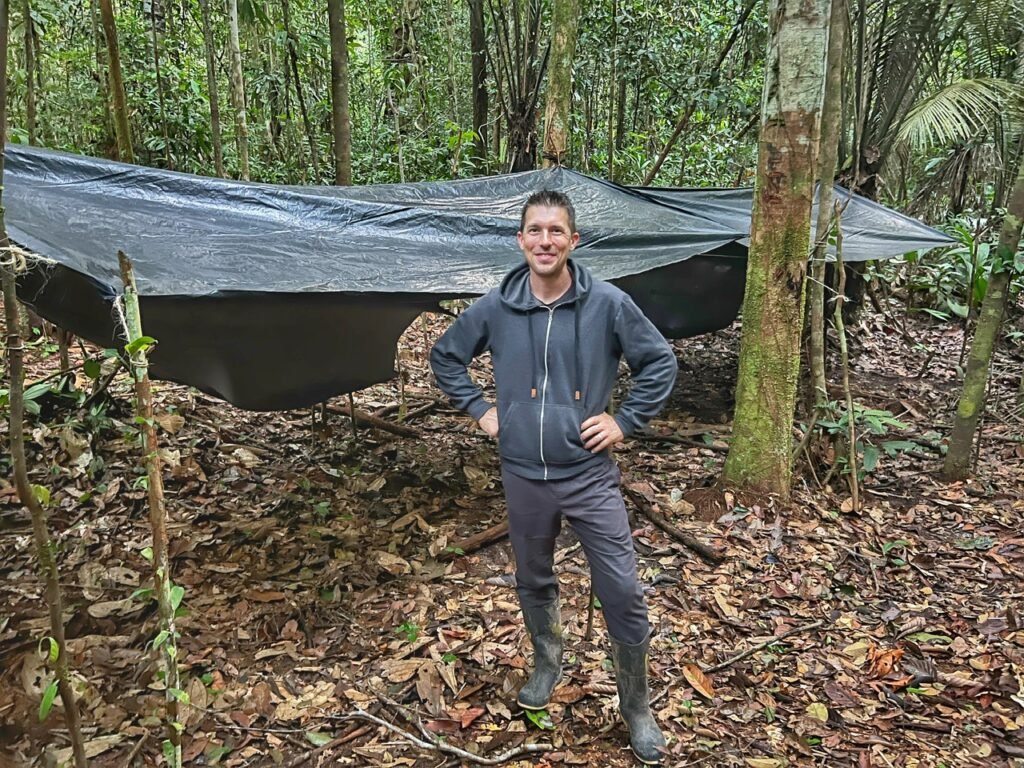
And rain tarps, which actually were not needed. We were surprised how little in rained even though June is still considered on the tail end of “wet season.”
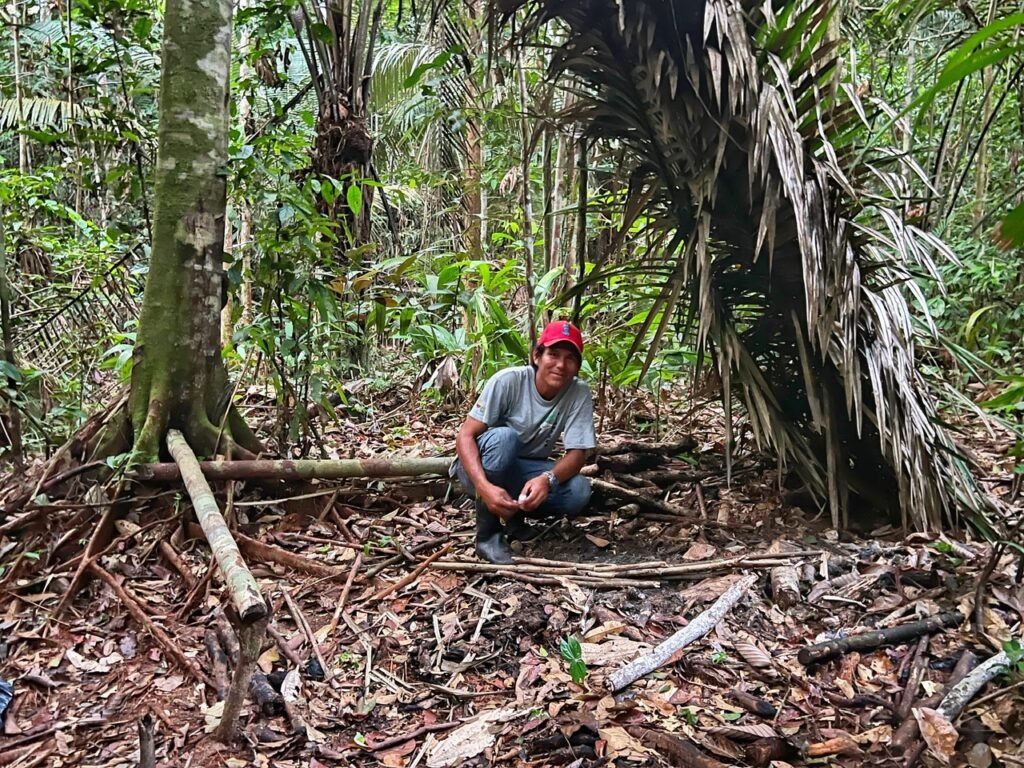
Hugo assembling our grill out of sticks using a machete. Under our personal palm frond awning, it felt way cooler than reality TV.
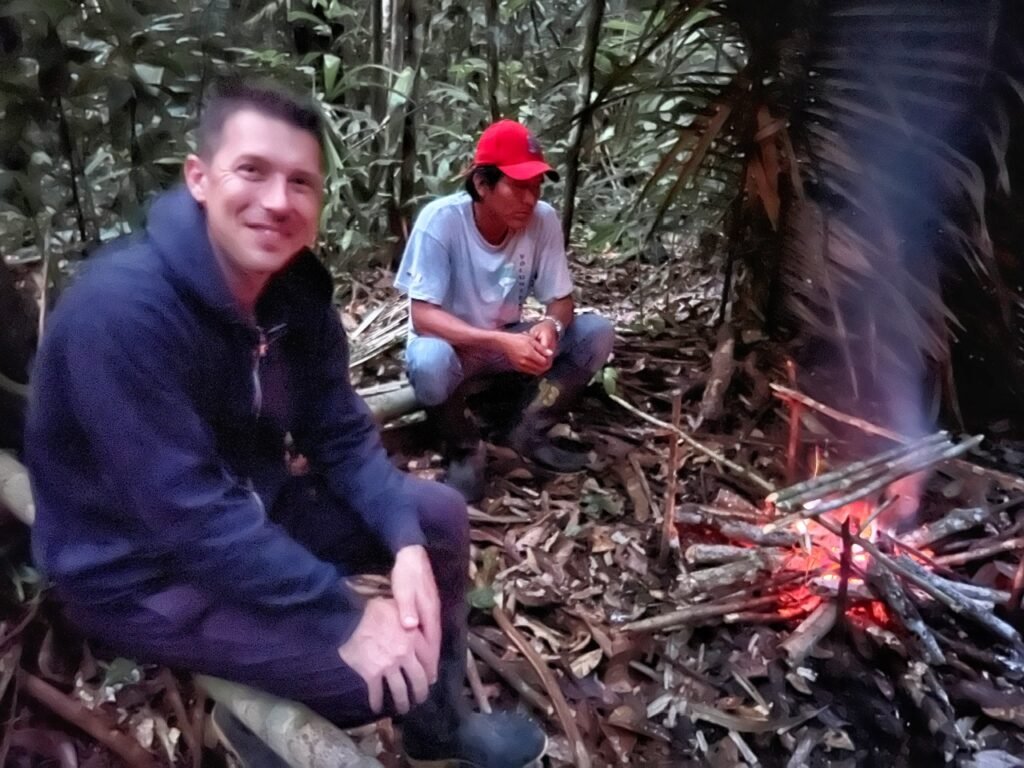

To start the fire, Hugo cheated (not that we blamed him) and used a lighter trying at first just wood, then wood shavings and after not having success with those two things, a piece of a plastic bag. Oh oil. How do those indigenous tribes do it without you?! 🤣
Mandy nearly squealed when Marcos whipped out our dinner…five giant Pintodillo (or Sirubi in Portuguese) steaks, which is the tiger-marked fresh water fish we’d picked up on the boat ride into the reserve. Although we’d already had it baked in delicious sauces for lunch, over the fire in the middle of the jungle, this pink fish became the most succulent fish we’ve ever had in our lives. Hardly any bones, which is good because we were eating by light of a fire, firm but tender and positively creamy with healthy fats. Kinda like the healthy fish version of a cheesecake.
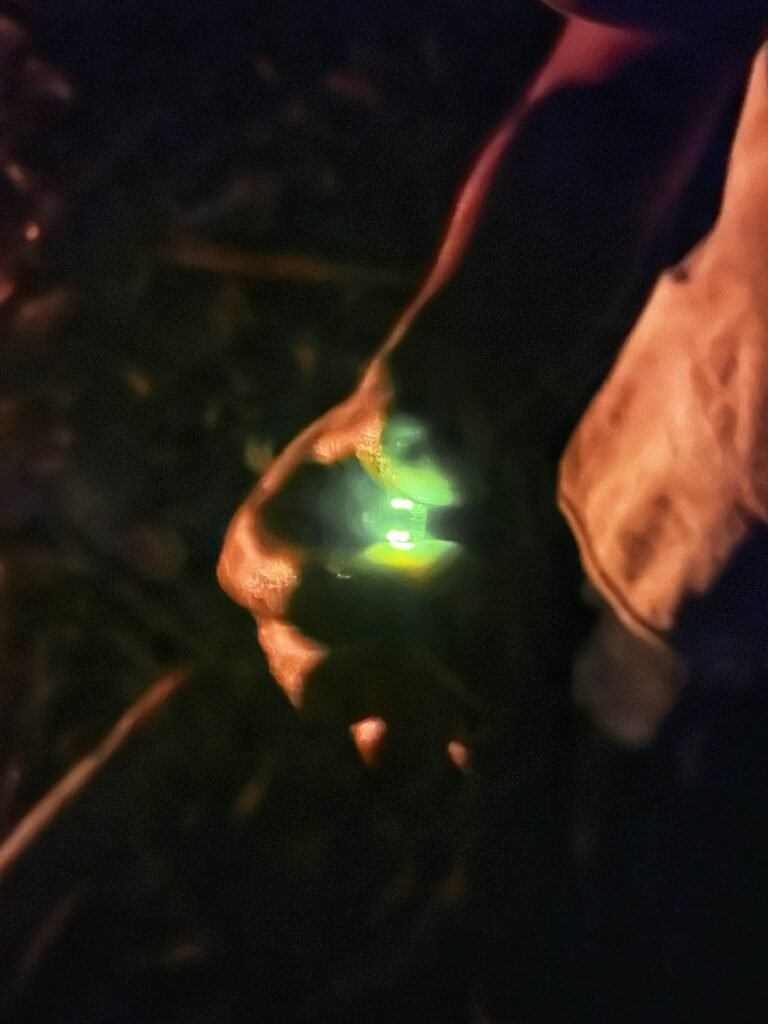
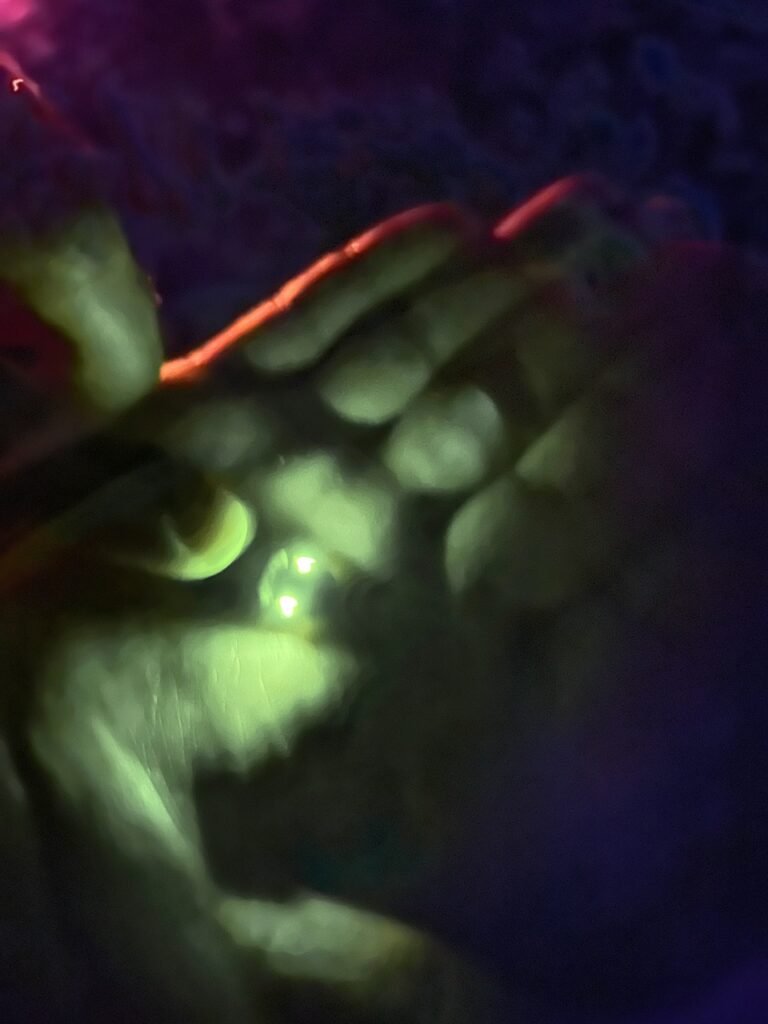
It didn’t take long for the jungle to begin coming to life around us and the next few hours were by far the most incredulous. The sounds…curiously foreign in every way, the constant movement through the bush, and the unexpected amount of light emerging from the twisted trees became simultaneously intoxicating and hair-raising at the same. One such insect flashed recurrently and we initially thought it was a firefly. However, we quickly realized that unlike a firefly, the flashes were green, not yellow, and they emitted from two eyes, not one taillight.
According to Hugo, the insect is called a Luciérnaga and is about nose length long. They’re pretty jumpy so it was very difficult to photograph. The adults light up the sky near the rivers each night in order to attract mates. Turns out, upon looking up the word luciernaga, it was indeed…a firefly. Haha. 🤨

And while we were so busy looking up, this guy trying to keep warm, crawled right into our campfire. And holy 💩 .


For those of you who remember the scene in “Indiana Jones and the Temple of Doom” when Willy walks through the insect infested cave, breaks a nail, gets pissed off and then turns her hand over to find a hand sized insect on her palm, this is clearly where Spielberg got his inspiration.
Hugo said the giant looking insect is called a Grillo. When we looked up Grillo, it meant cricket. Sorry dude. That jungle monster is not a cricket. 🤣

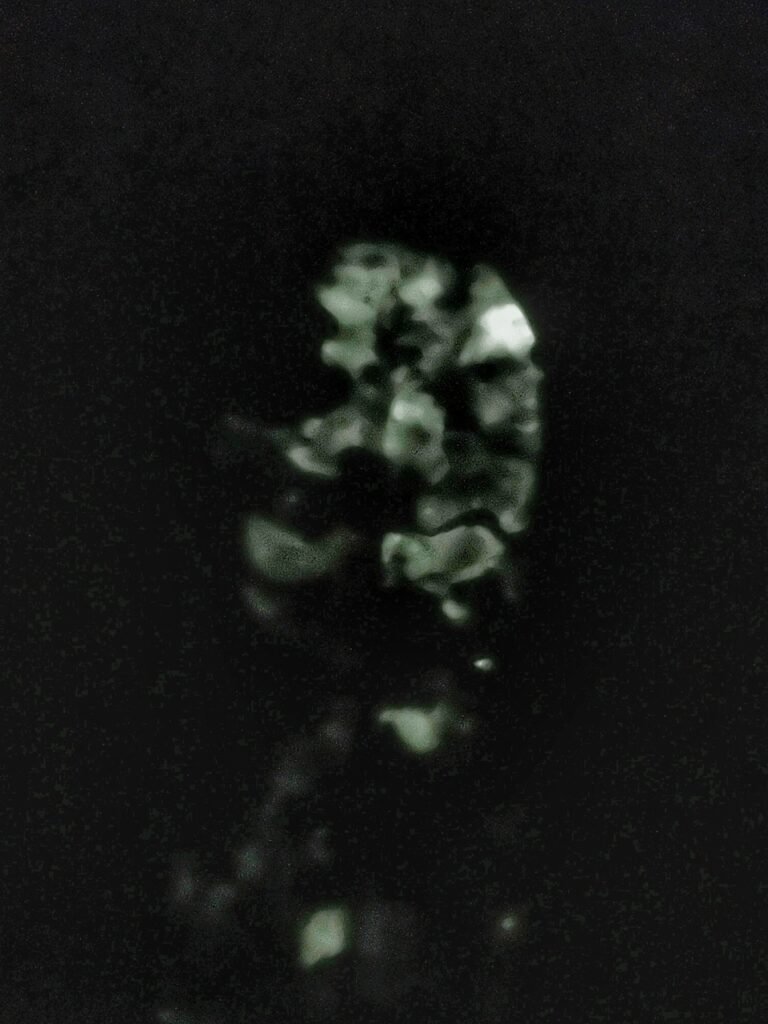
Also, they showed us how an everyday ordinary leaf can turn into a glowing Avatar-esque experience as soon as the lights go off. Bioluminescence is often found on fungi to attract insects at night to move spores around, evidently.
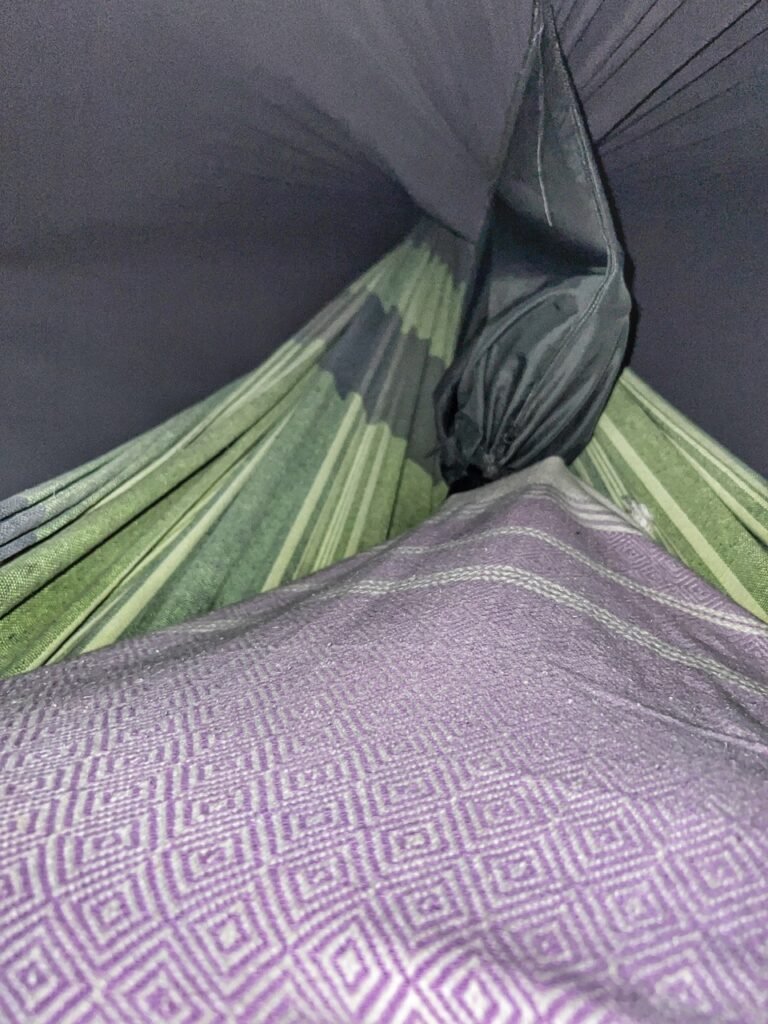
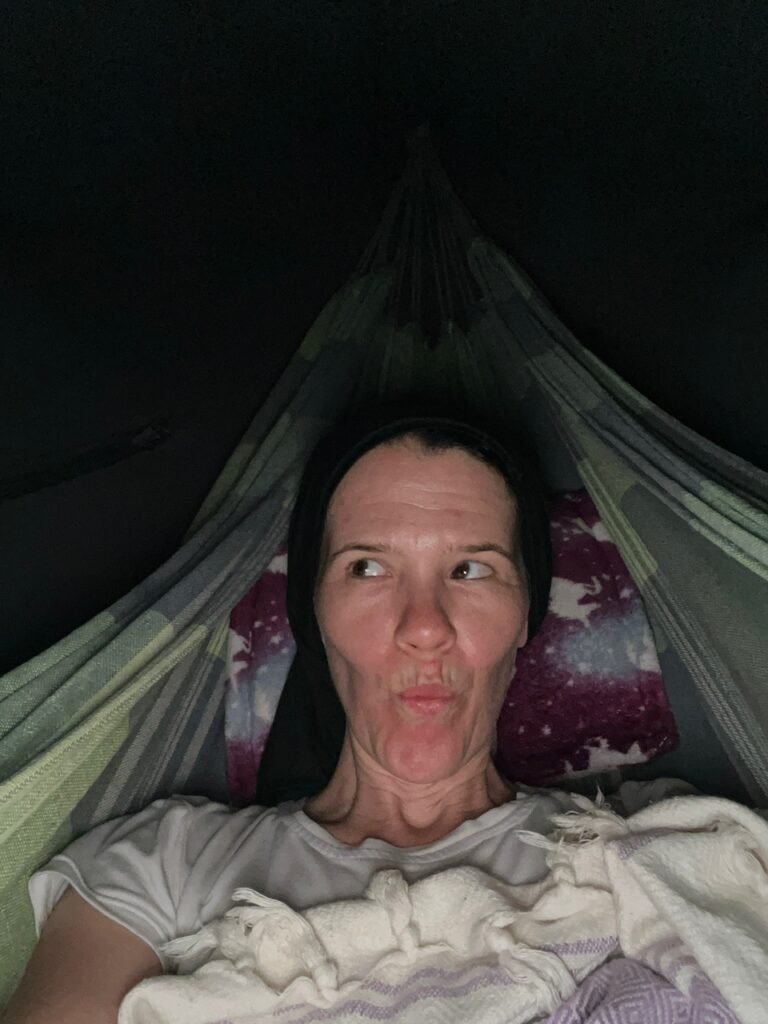
After checking out the creepies and crawlies around us, it was 8:00 and time to retire to our pods for the evening, where we’d be floating without each other’s protection for the next 10 hours. To do so, we had to hang our giant rubber boots upside down on sticks right at the zipper before crawling inside our sweat box. Fortunately, thanks to the encompassing mosquito net, there is a pocket below you to put your nastiest of clothes. It was Mandy’s first time sleeping (not napping) in a hammock and although Greg did it a LOT in his early-20’s backpacker days, admitted it was a bit harder now….🤣 Particularly with the cacophony outside your “window.” But the bigger fear, of course is not, what’s out there…but will I have to go the bathroom?!

